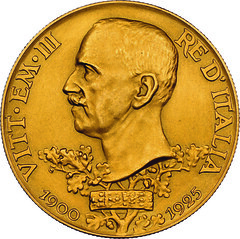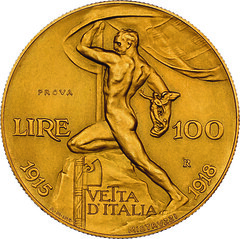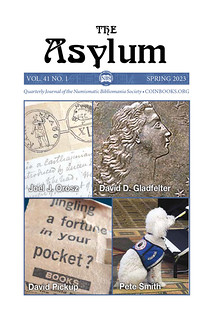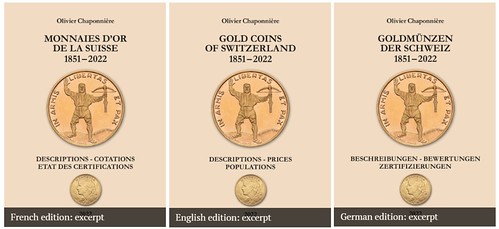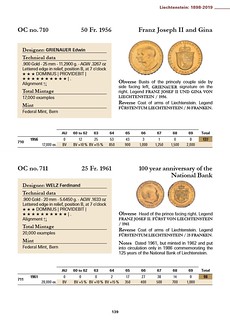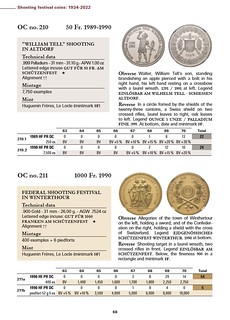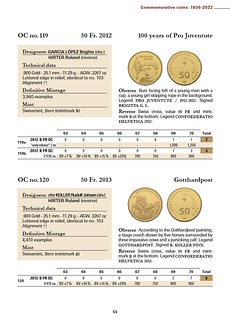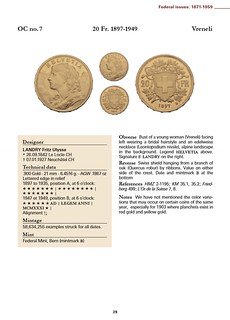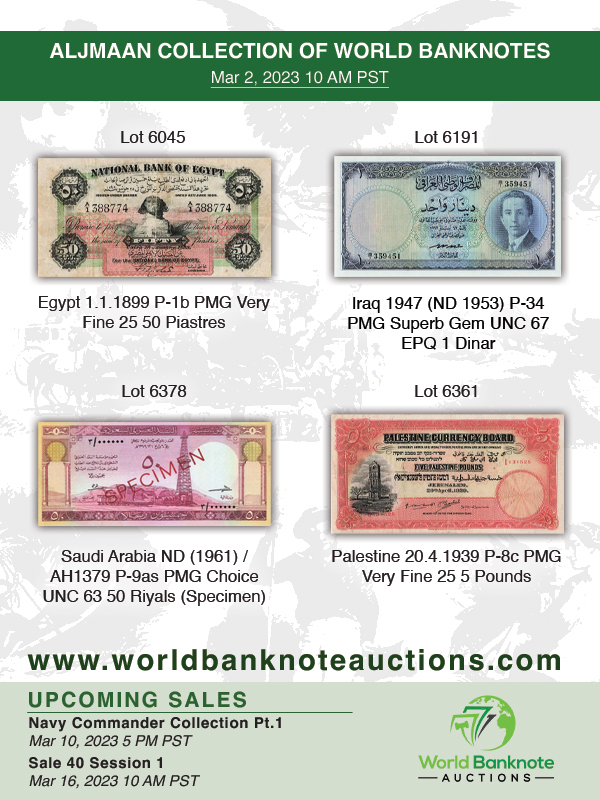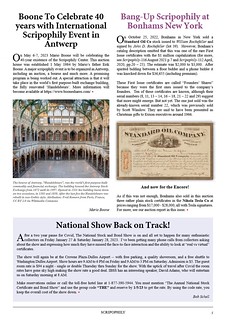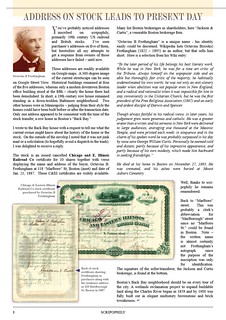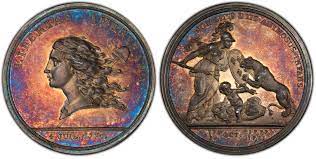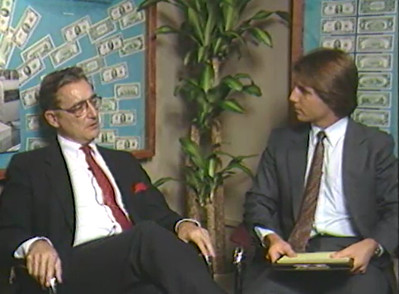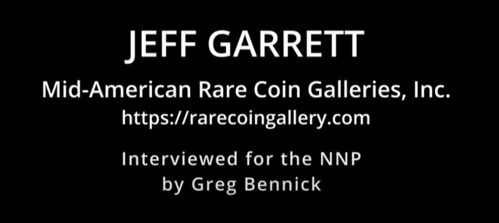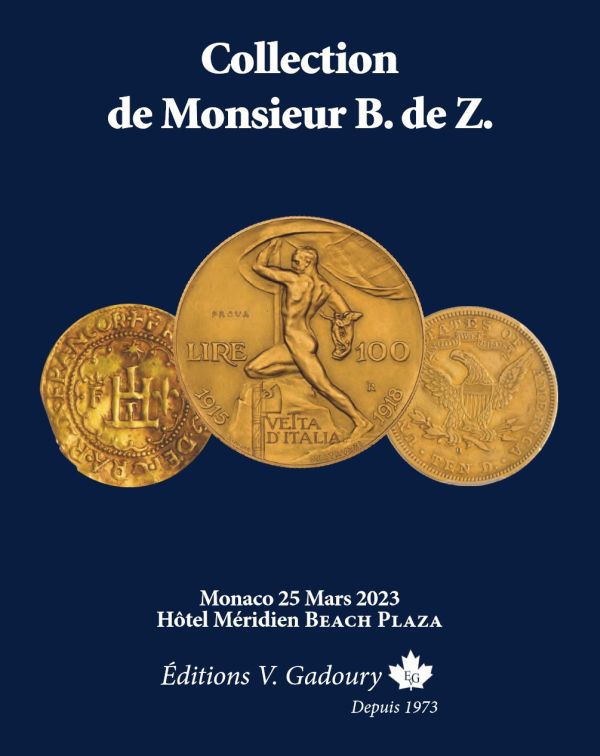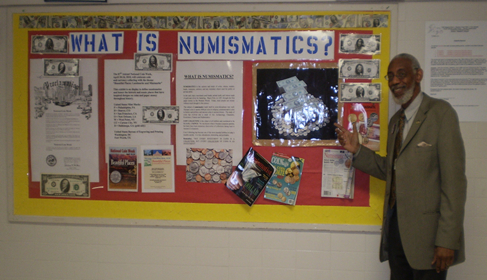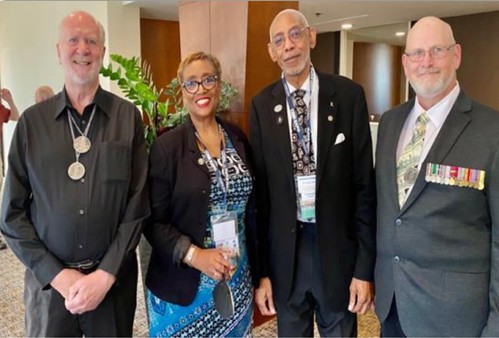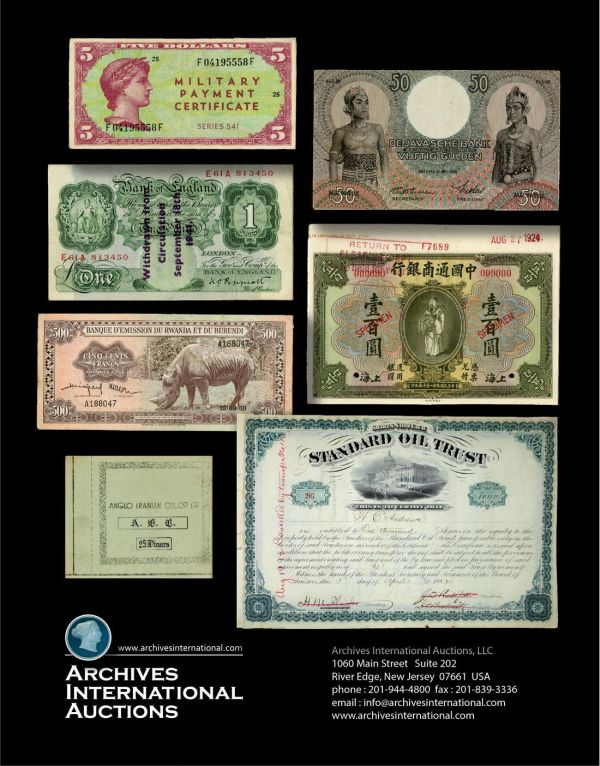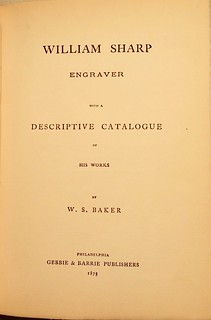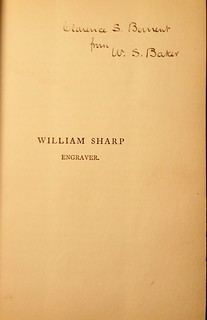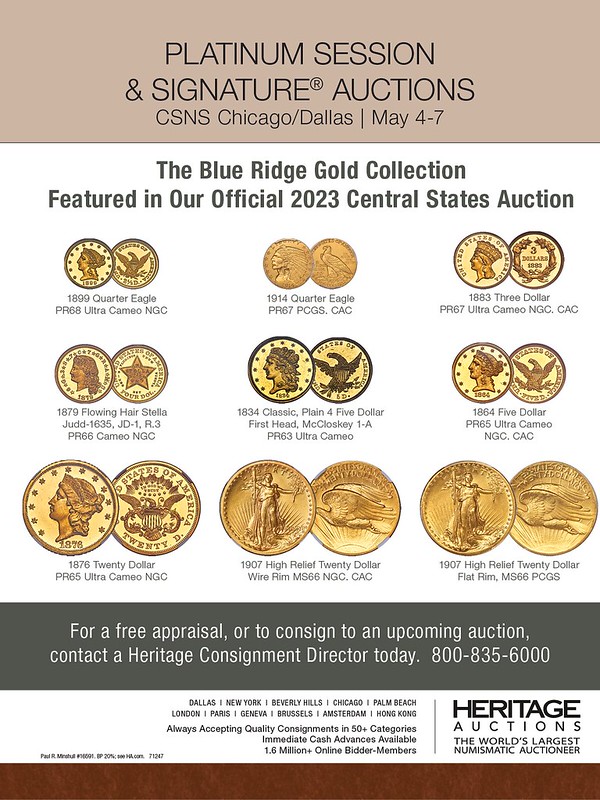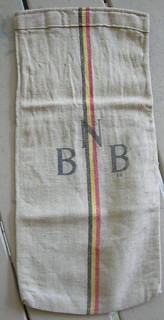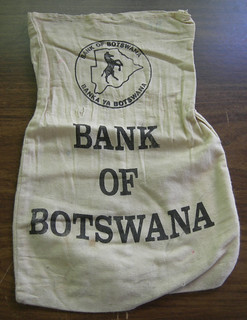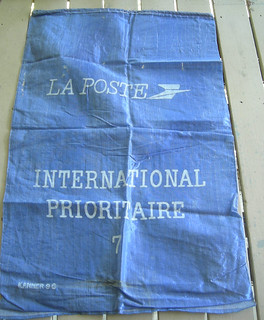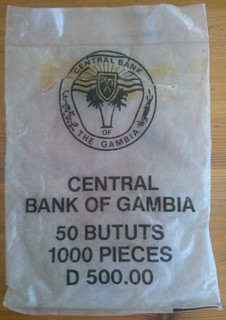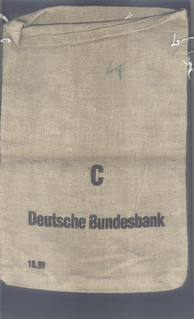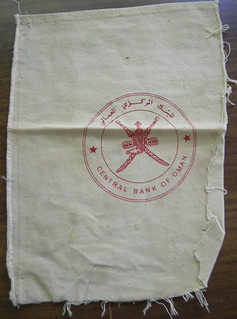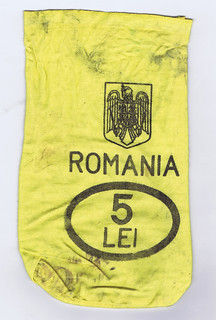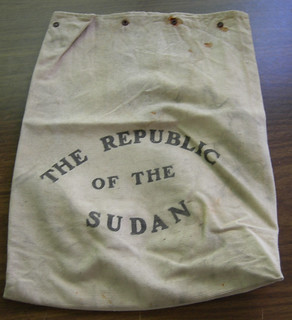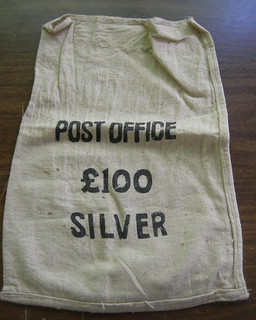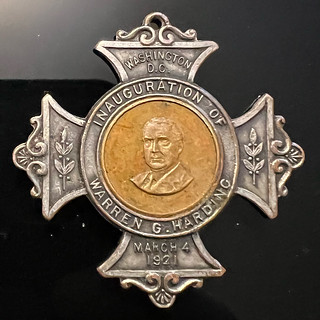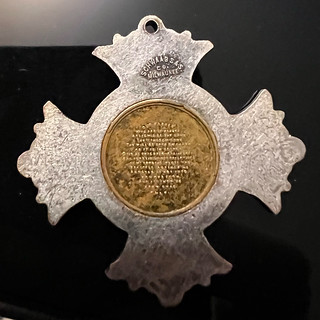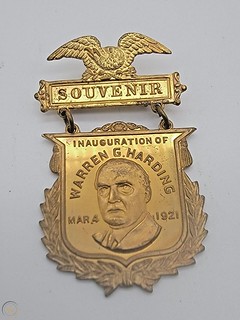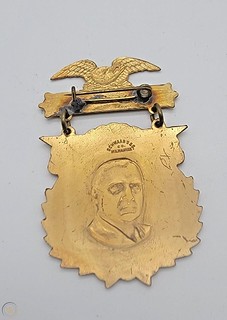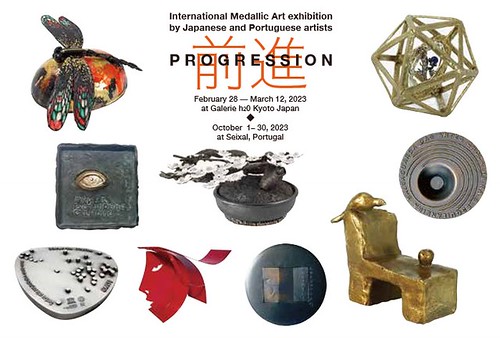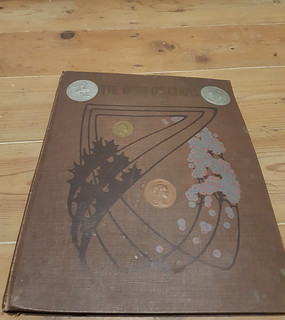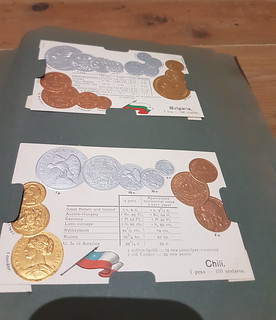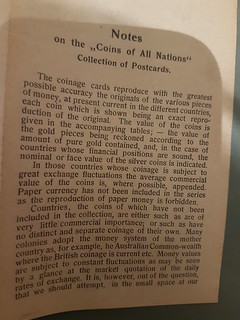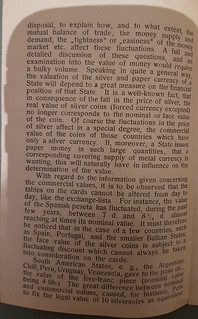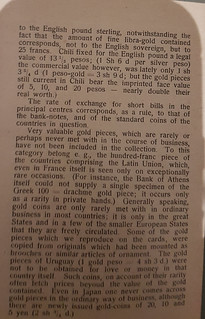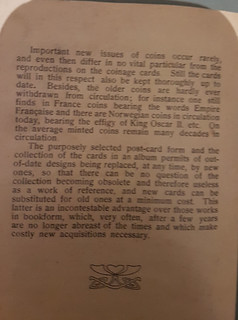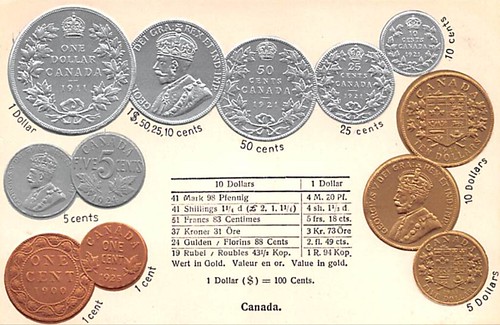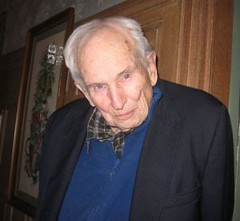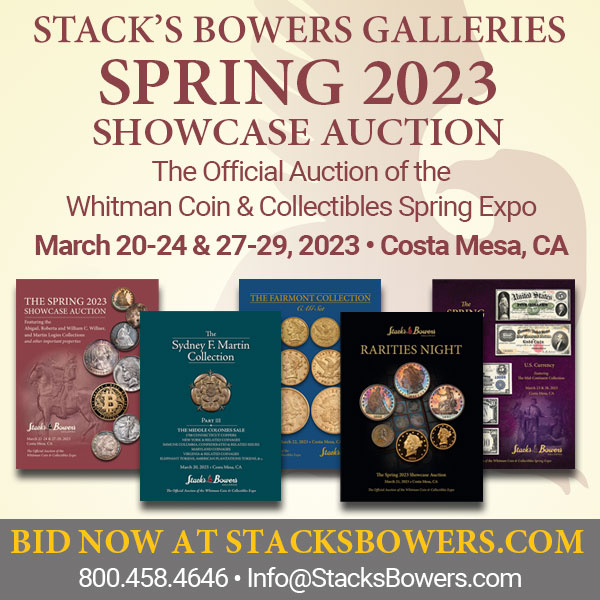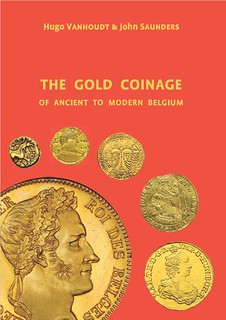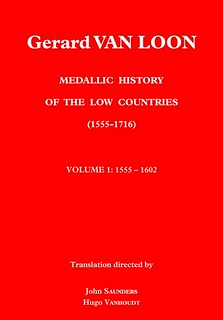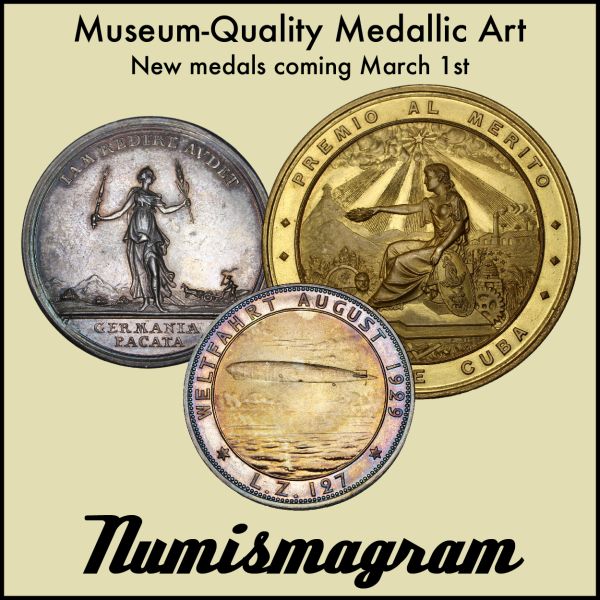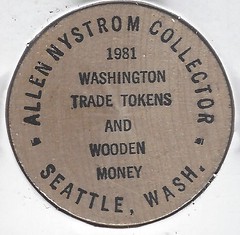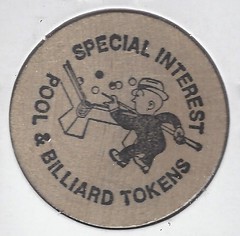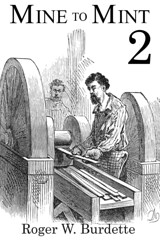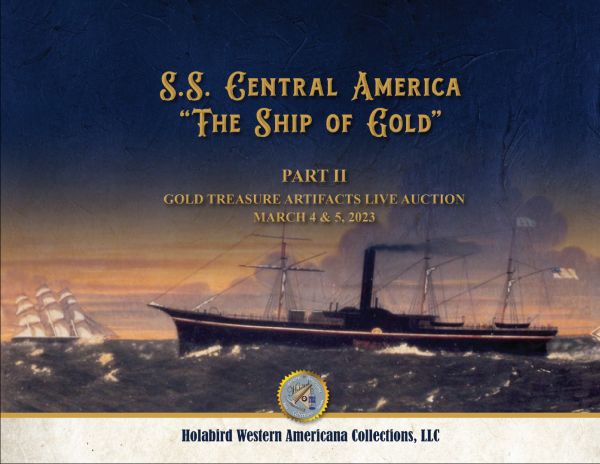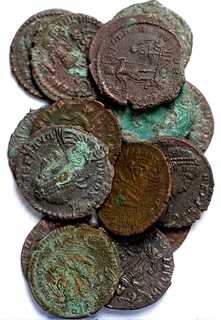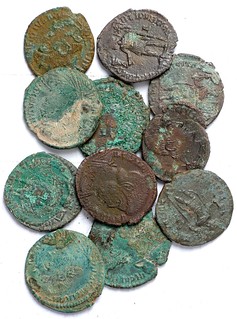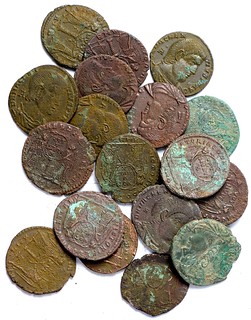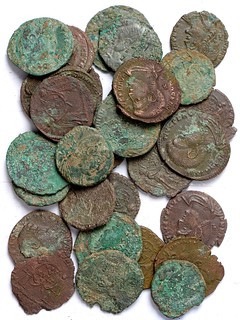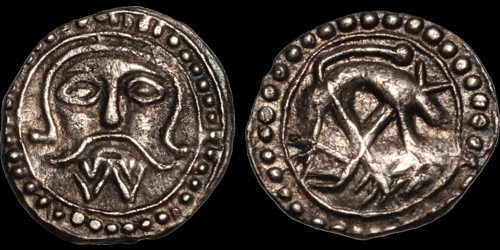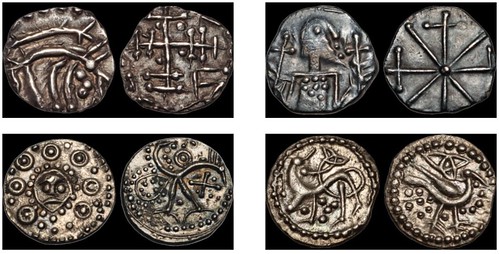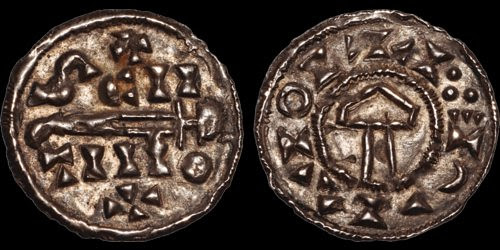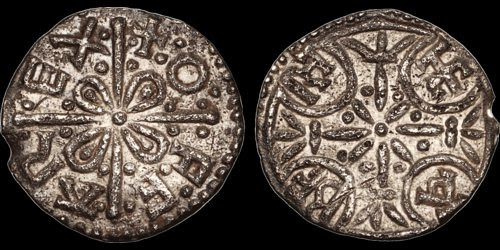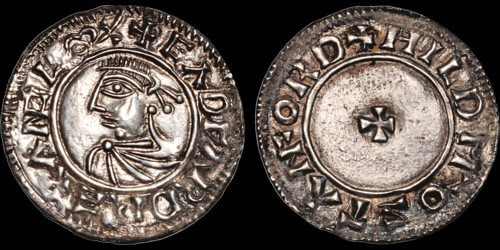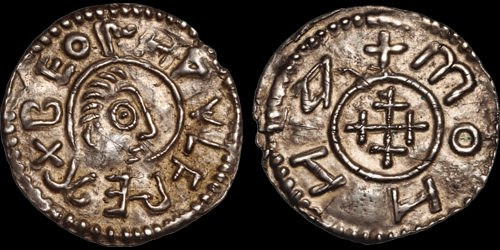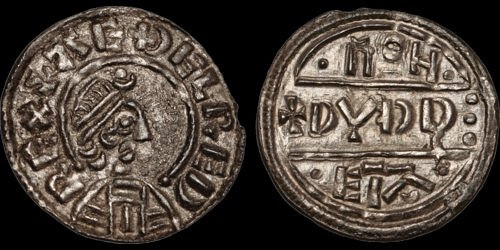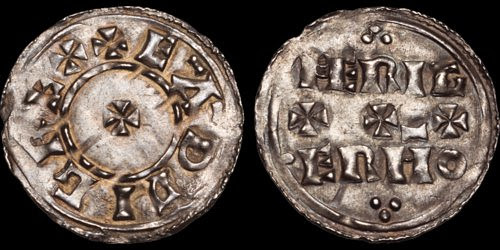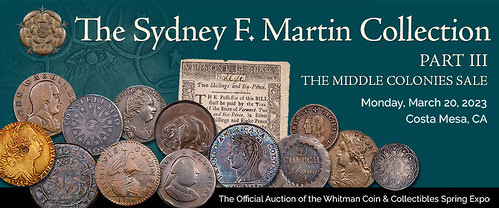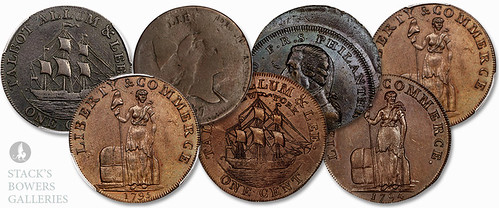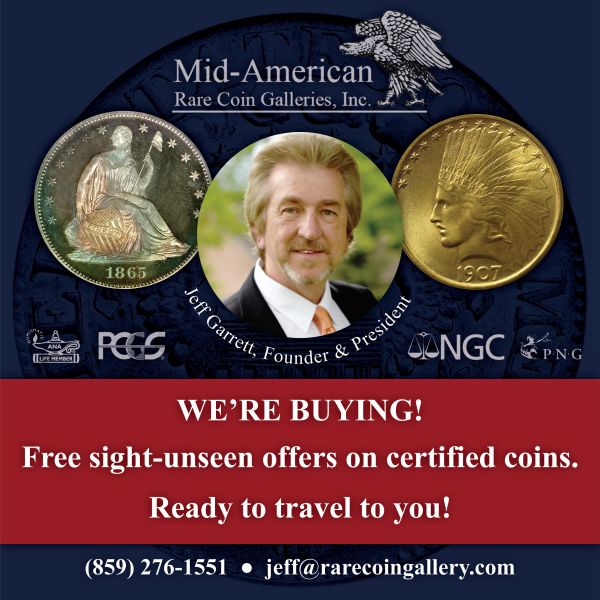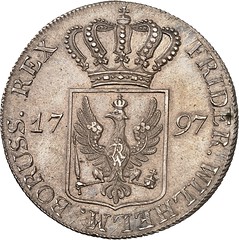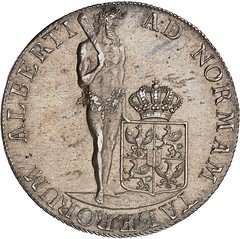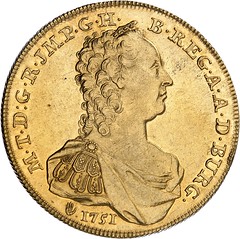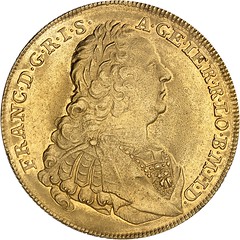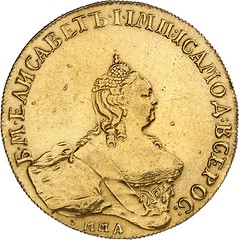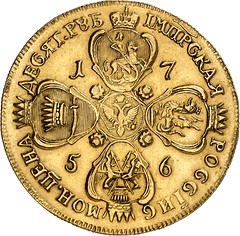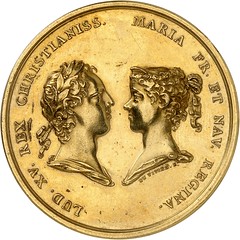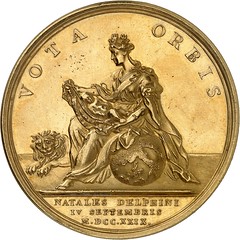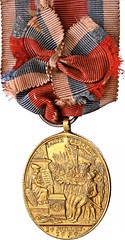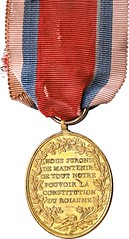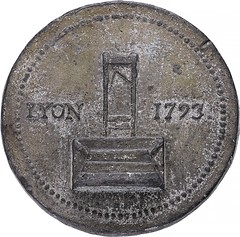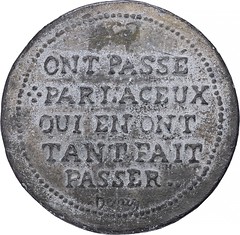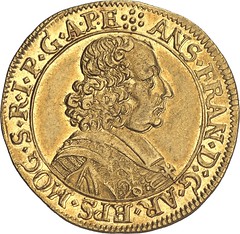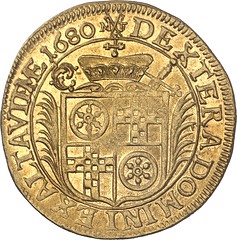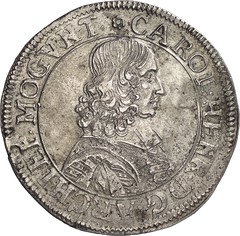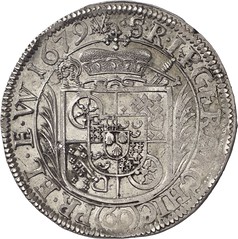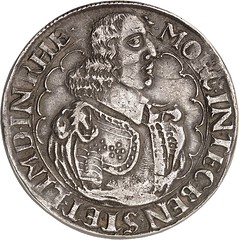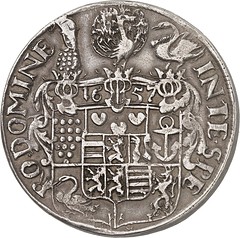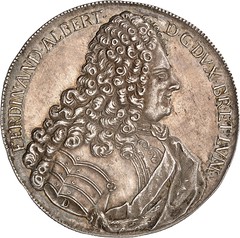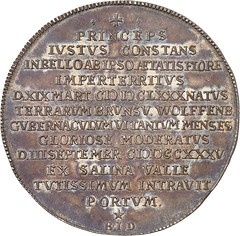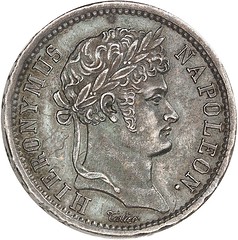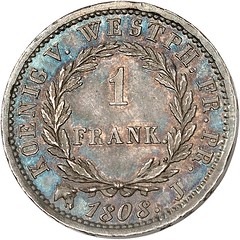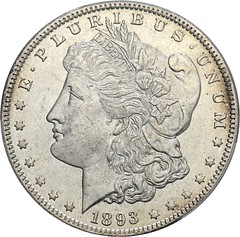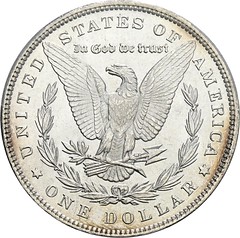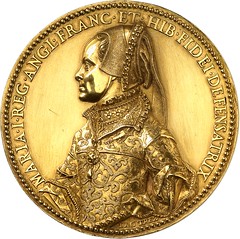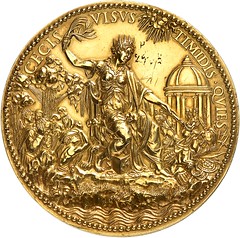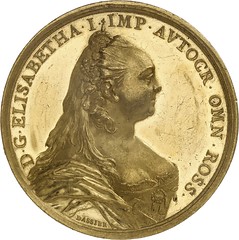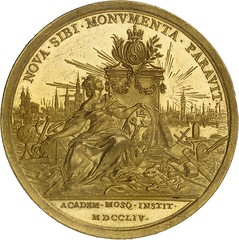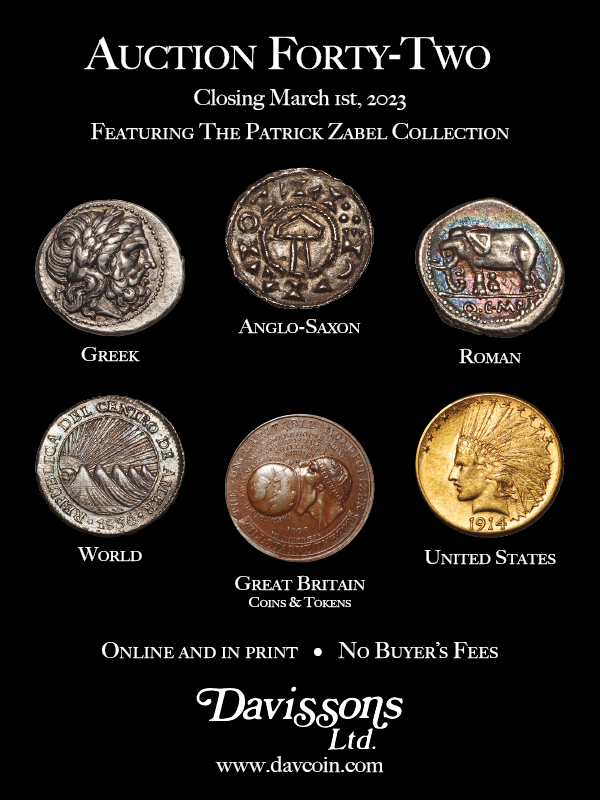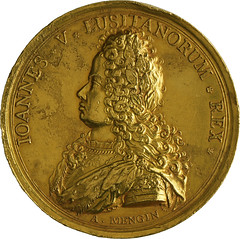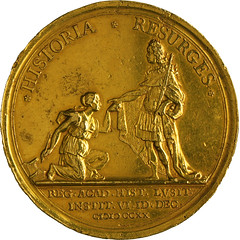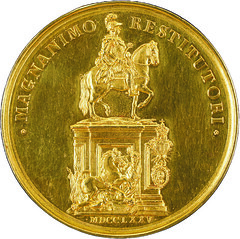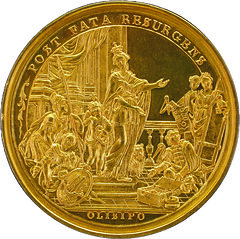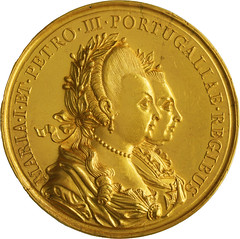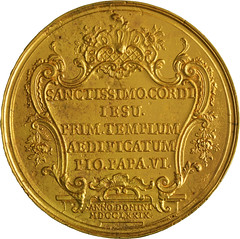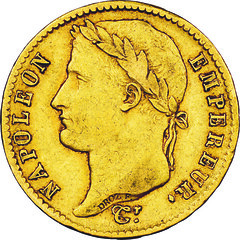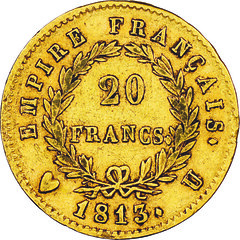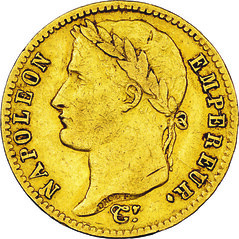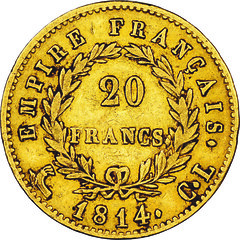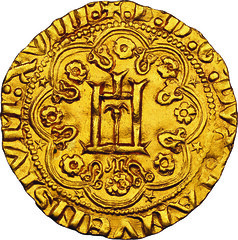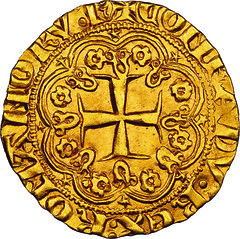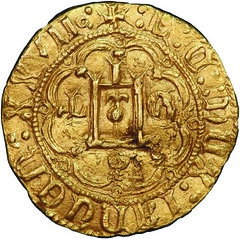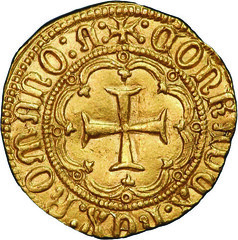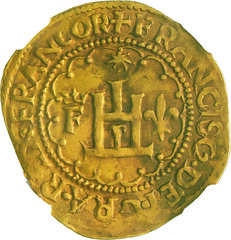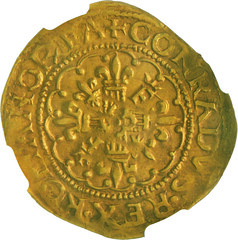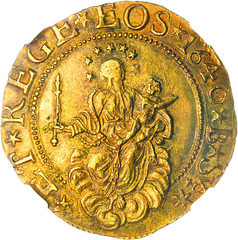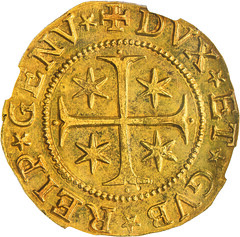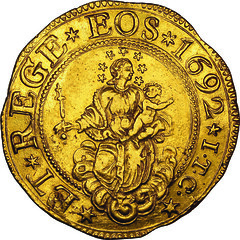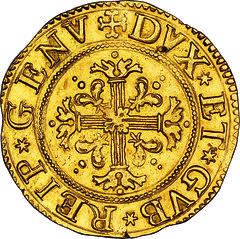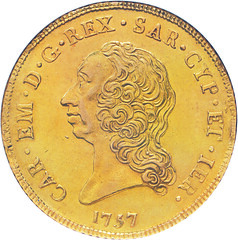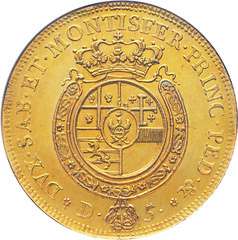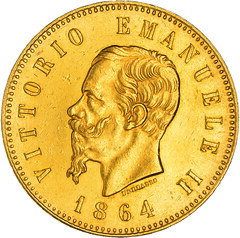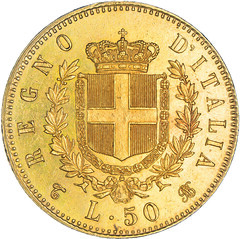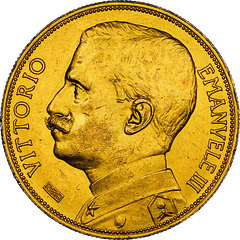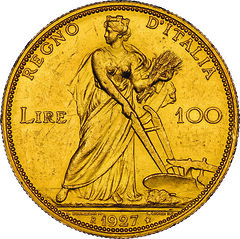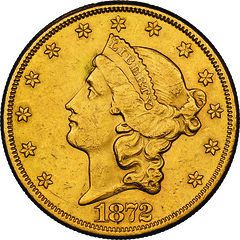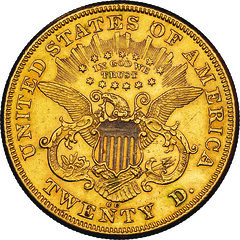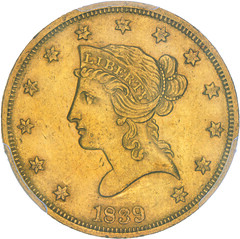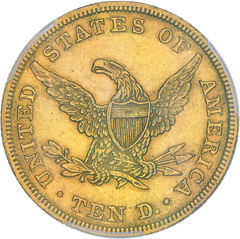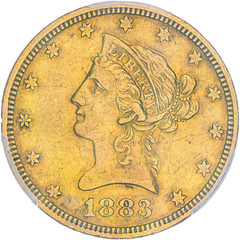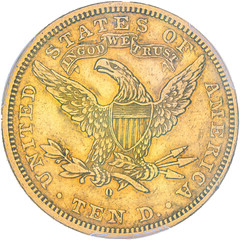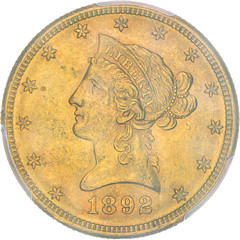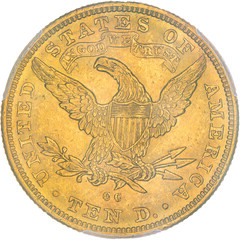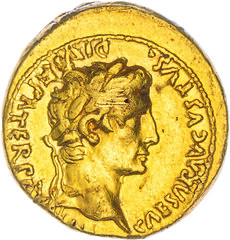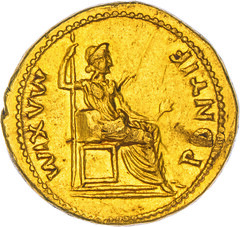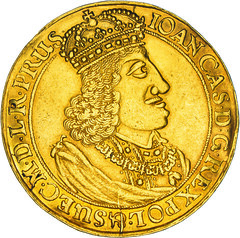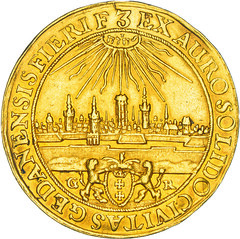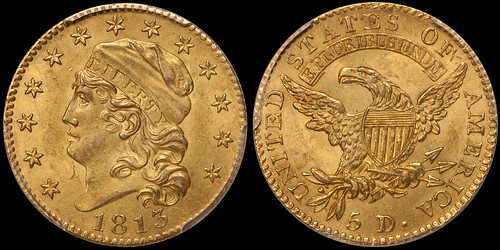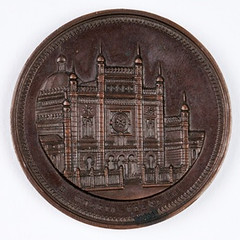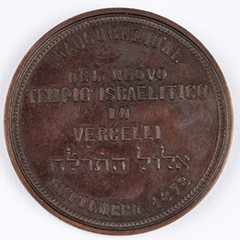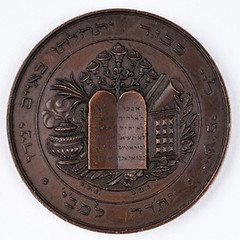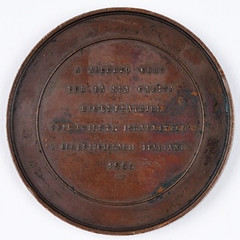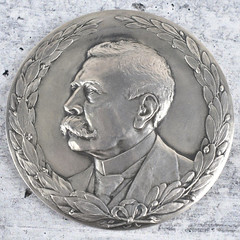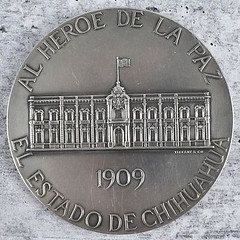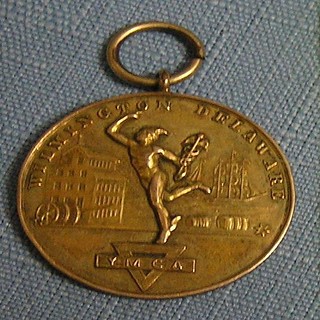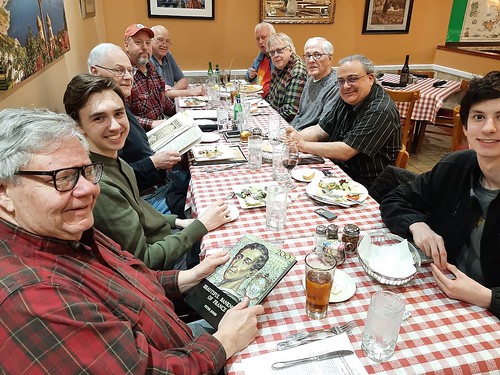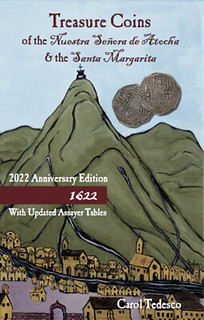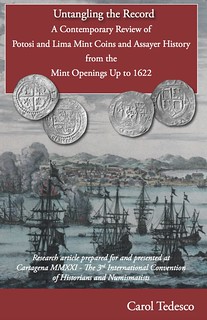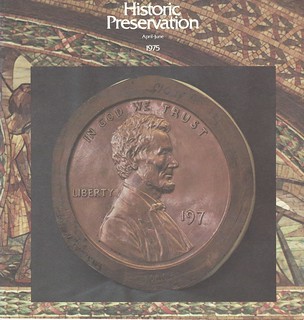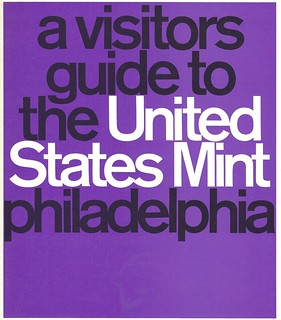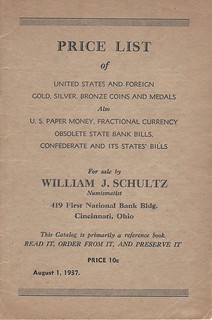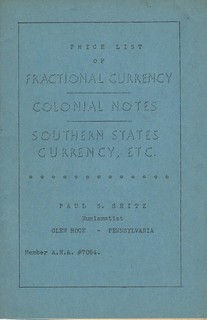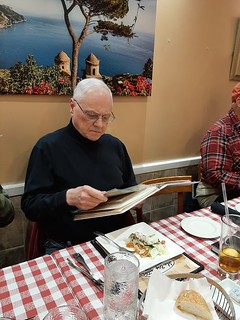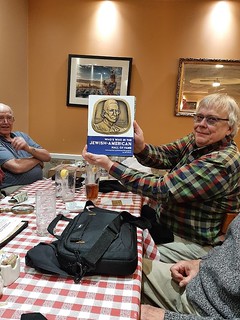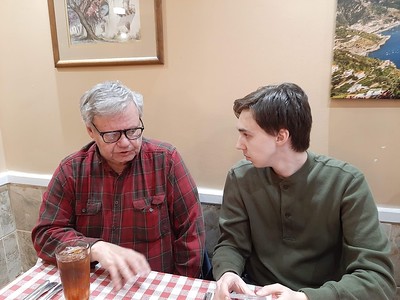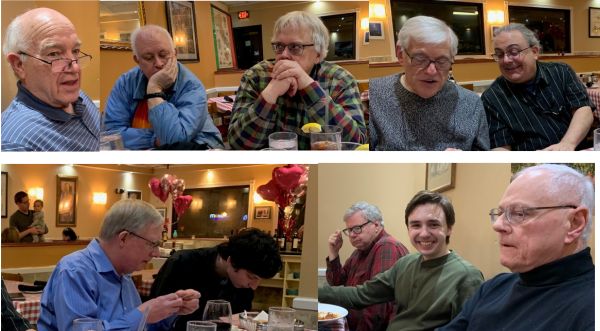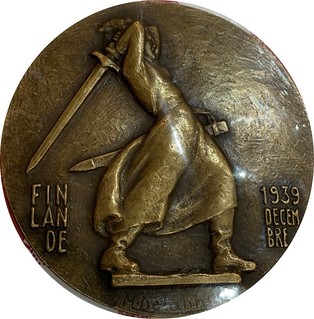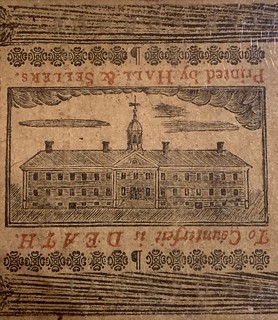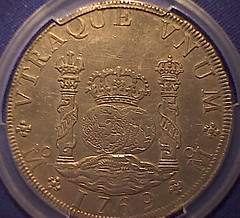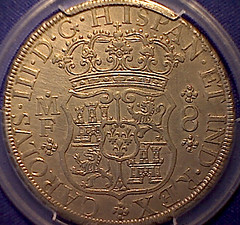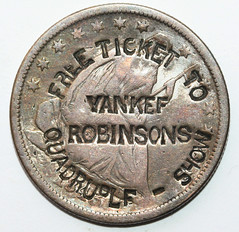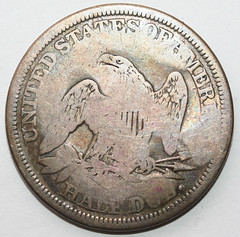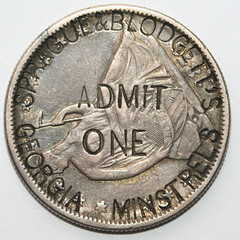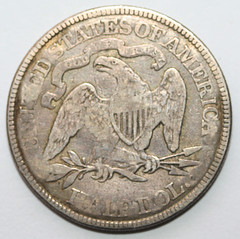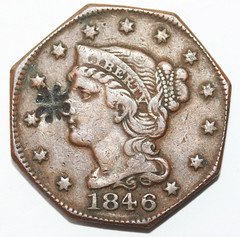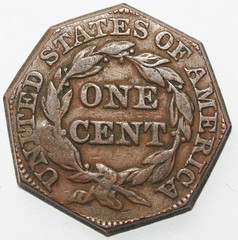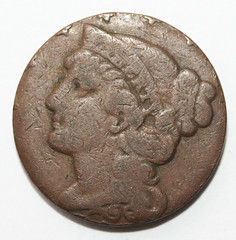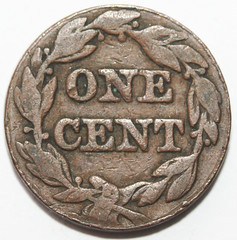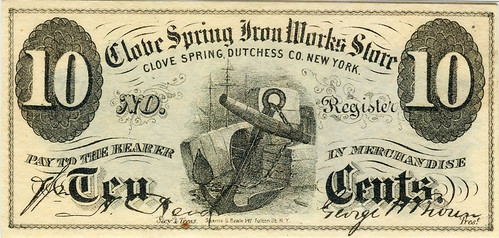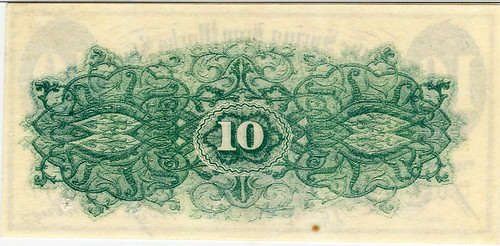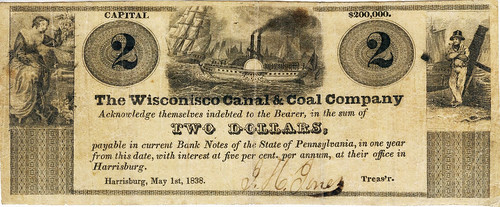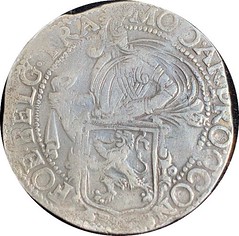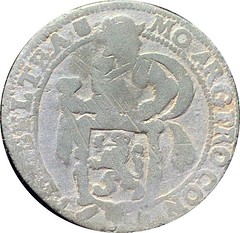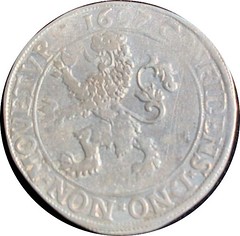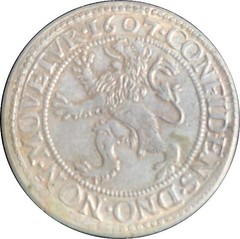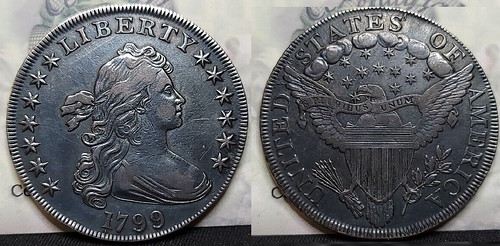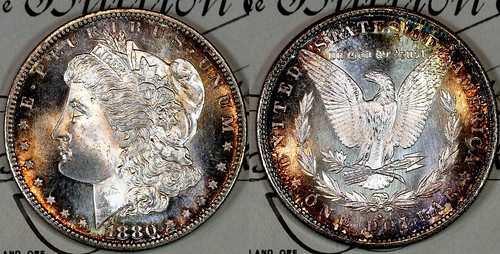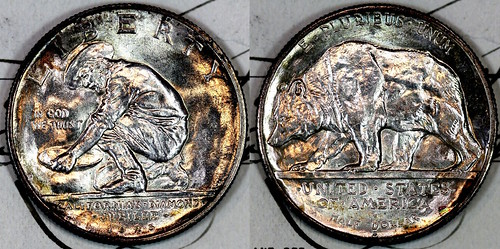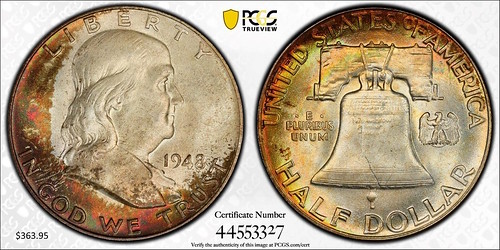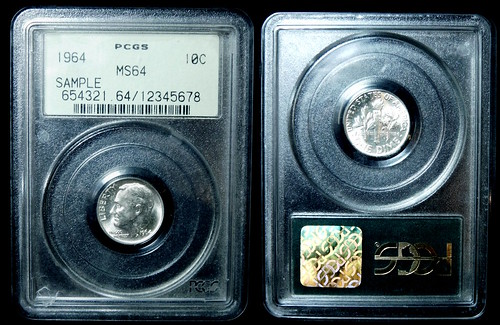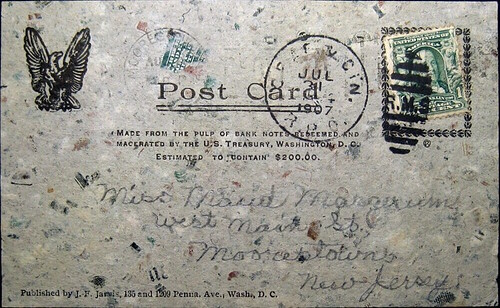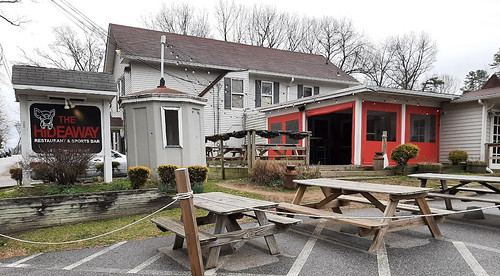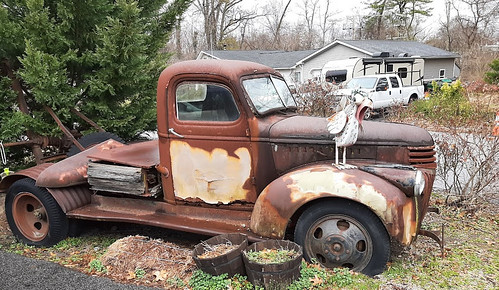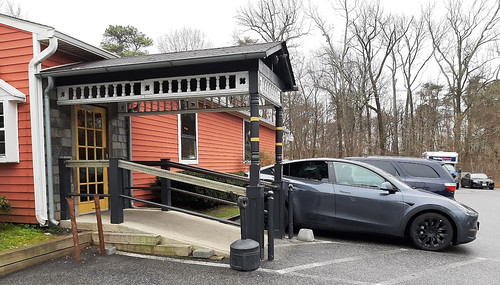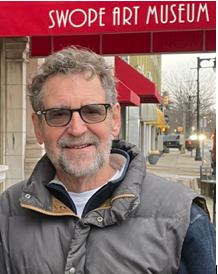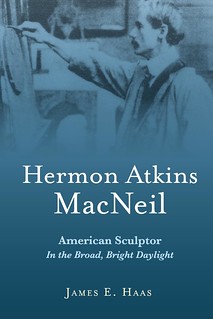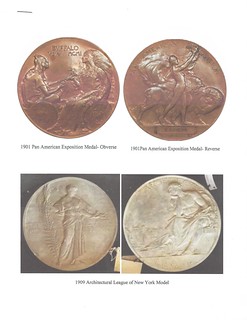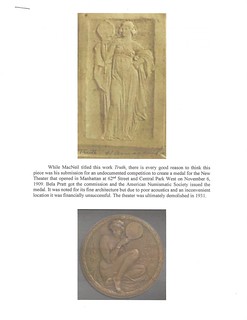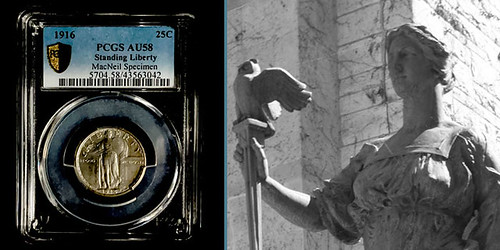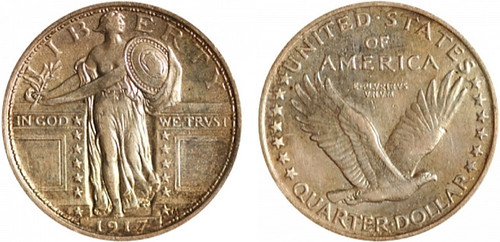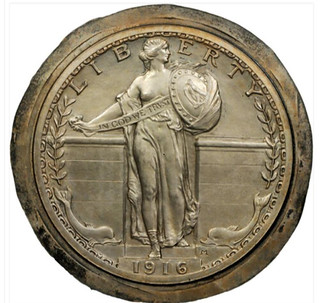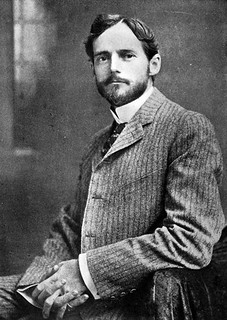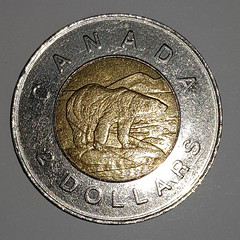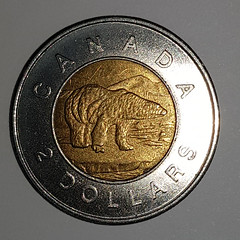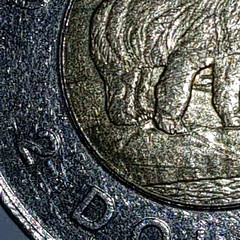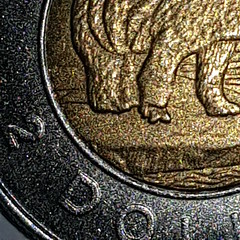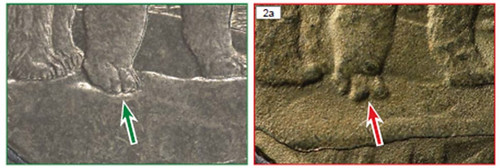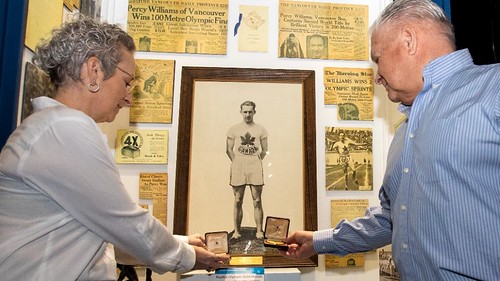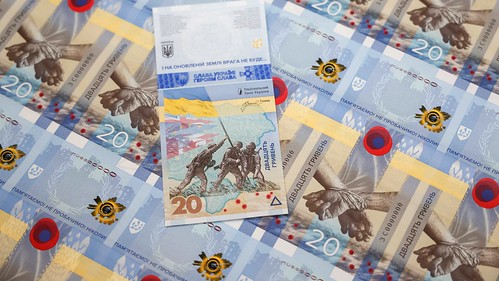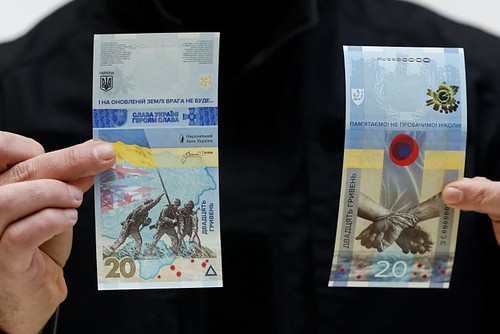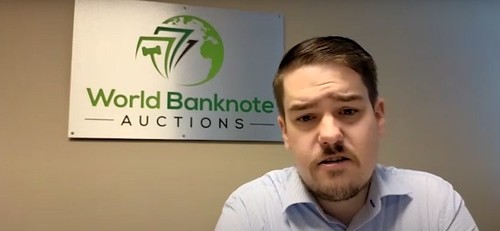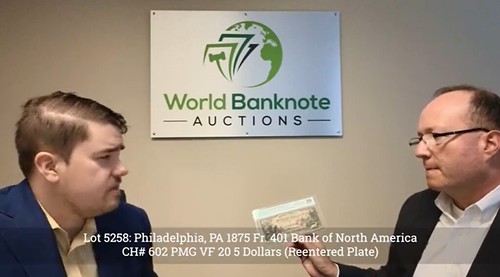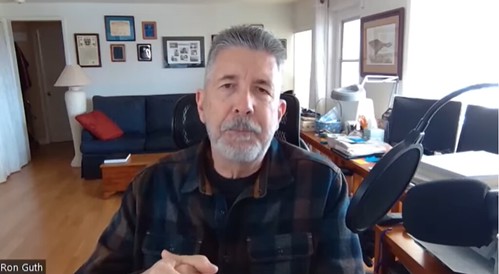
Visit our NBS Sponsors




About UsThe Numismatic Bibliomania Society is a non-profit association devoted to the study and enjoyment of numismatic literature. For more information please see our web site at coinbooks.org SubscriptionsThose wishing to become new E-Sylum subscribers (or wishing to Unsubscribe) can go to the following web page link MembershipThere is a membership application available on the web site Membership Application To join, print the application and return it with your check to the address printed on the application. Print/Digital membership is $40 to addresses in the U.S., and $60 elsewhere. A digital-only membership is available for $25. For those without web access, write to: Charles Heck, Treasurer AsylumFor Asylum mailing address changes and other membership questions, contact Chuck at this email address: treasurer@coinbooks.org SubmissionsTo submit items for publication in The E-Sylum, write to the Editor at this address: whomren@gmail.com BUY THE BOOK BEFORE THE COINSale Calendar
Watch here for updates! |
- WAYNE'S WORDS: THE E-SYLUM FEBRUARY 26, 2023
- ASYLUM SPRING 2023 ISSUE PUBLISHED
- NEW BOOK: GOLD COINS OF SWITZERLAND 1851-2022
- SCRIPOPHILY DECEMBER 2022 ISSUE PUBLISHED
- NNP ADDS JEFFERSON COMITIA AMERICANA LIST
- NEWMAN PORTAL CONGRESSIONAL DOCUMENTS
- VIDEO: ROBERT LEUVER
- JEFF GARRETT INTERVIEW, PART THREE
- RALPH W. ROSS, A ST. ELIGIUS KNIGHT
- BAKER'S BOOK ON WILLIAM SHARP, ENGRAVER
- COIN BAGS OF THE WORLD
- NOTES FROM E-SYLUM READERS: FEBRUARY 26, 2023
- A COIN POSTCARD ALBUM
- 2023 ROCKWELL LECTURE: SYDNEY F. MARTIN COLLECTION
- HANNA ANTONINA JELONEK RECEIVES SALTUS AWARD
- JOHN SAUNDERS APPOINTED TO CCAC
- MINT PRESENTS BESSIE COLEMAN QUARTER TO FAA
- VOCABULARY TERM: MINTMASTER
- ALLEN NYSTROM (1909-2009)
- WHY THE FIRST MINT STAYED IN PHILADELPHIA
- ST. JAMES'S COMPTON DUNDON HOARD AUCTION
- DAVISSONS AUCTION 42 ANGLO-SAXON
- SYDNEY F. MARTIN COLLECTION PART THREE
- SYD MARTIN TALBOT, ALLUM & LEE CENTS
- KUENKER SPRING 2023 AUCTION SALES 385-386
- GADOURY MARCH 2023 AUCTION
- NUMISMATIC NUGGETS: FEBRUARY 26, 2023
- WAYNE'S NUMISMATIC DIARY: FEBRUARY 26, 2023, PART 1
- WAYNE'S NUMISMATIC DIARY: FEBRUARY 26, 2023, PART 2
- COUNTERFEIT CANADIAN 'CAMEL TOE' TOONIES
- 1849 OREGON FIVE DOLLAR GOLD BEAVER COIN
- STOLEN OLYMPIC GOLD MEDALS REPLACED
- UKRAINE BANKNOTE MARKS ONE YEAR OF WAR
- LOOSE CHANGE: FEBRUARY 26, 2023
- FEATURED WEBSITE: COUNTERFEIT TOONIES
Click here to read the thin version on the web
Click here to subscribe
Click here to access the complete archive
To comment or submit articles, reply to whomren@gmail.com
Content presented in The E-Sylum is not necessarily researched or independently fact-checked, and views expressed do not necessarily represent those of the Numismatic Bibliomania Society.
WAYNE'S WORDS: THE E-SYLUM FEBRUARY 26, 2023
 New subscribers this week include:
Bob Dolle, courtesy Steve Hill;
Ron Hight , courtesy of Wayne Davis; and
Gene Goodine of the Pine Tree Coin Club in Bangor, Maine.
Welcome aboard!
New subscribers this week include:
Bob Dolle, courtesy Steve Hill;
Ron Hight , courtesy of Wayne Davis; and
Gene Goodine of the Pine Tree Coin Club in Bangor, Maine.
Welcome aboard!
Thank you for reading The E-Sylum. If you enjoy it, please send me the email addresses of friends you think may enjoy it as well and I'll send them a subscription. Contact me at whomren@gmail.com anytime regarding your subscription, or questions, comments or suggestions about our content.
Happy Birthday, Hermon Atkins MacNeil!
This week we open with a new Asylum issue, one new book (in three languages), updates from the Newman Numismatic Portal, world coin bags and more.
Other topics this week include the Comitia Americana medals, Bob Leuver, Jeff Garrett, Ralph Ross, William Sharp, Syd Martin, St. Eligius, coin postcards, the first U.S. Mint, the Compton Dundon hoard, and counterfeit Canadian toonies.
To learn more about gold coins of Switzerland, U.S. Congressional documents related to coinage, "rainbow" currency rumors, a complete set of Templeton Reid gold coins, buying a the 1913 Liberty nickel, the SCAMS grading system, Thomas P. Rockwell, John Saunders, Allen Nystrom, the Pat Zabel collection of Anglo-Saxon coins, Albany Church Pennies and camel toe coins, read on. Have a great week, everyone!
Wayne Homren
Editor, The E-Sylum
ASYLUM SPRING 2023 ISSUE PUBLISHED
The Spring 2023 issue of The Asylum is on the way from our sponsor, the Numismatic Bibliomania Society. Maria Fanning edits our print journal, and she submitted this report. -Editor
The Asylum Spring 2023 Issue
- ASSOCIATIONS: Autographs • Annotations • Inscriptions Charles Ira Bushnell's Flandin's Catalogue of Coins and Medals: Part IV, Installment 1: The Winslow J. Howard Sale, May 17, 1856 By Joel J. Orosz
- A Rose by Any Other Name: Jack Collins versus Martin Logies By David D. Gladfelter
-
A Fist Full of Halfcrowns: Margaret Amstell and An Early
Check your Change
By David Pickup - Fake Names in Numismatics By Pete Smith
- Trivia Quiz: 1990s style, Answers to last issue's quiz By Charles Davis
Message from NBS President Tom Harrison
NBS Board Election
This being the first quarter of an odd numbered year, it is again time to call for nominations for NBS officers and board members. If you wish to serve, please send a brief bio and portrait photo via email to Maria Fanning at nbsasylum@gmail.com by May 1st so you can be placed on the ballot to be mailed with the summer issue of The Asylum.
Be sure to check out the most recent NBS podcast, Bibliotalk, produced by Lianna Spurrier, that is now available on the NBS website. This episode is titled Numismatics in American Universities
and features enthusiastic numismatic ambassador Kellen Hoard. Kellen shares his collecting interests, discusses numismatic collections in universities, and explores various opportunities that online resources provide to introduce potential new collectors to the hobby.
If you plan to attend this summer's ANA World's Fair of Money, I invite you to consider entering a numismatic literature display. Your efforts will provide an opportunity to display a special volume, bring to light the writings of a favorite author, or showcase a collection of obscure works from your library. Your exhibit will provide conventioneers a chance to experience our fascinating sector of the hobby, and it may even spark their interest in our often overlooked but, as we all know, certainly worthy corner of numismatics.
May your library provide investigation, discovery, and most of all, enjoyment.
Remember, while The E-Sylum is free to all, only paid members of the Numismatic Bibliomania Society receive our print journal, The Asylum. Print/Digital membership is $40 to addresses in the U.S., and $60 elsewhere. A digital-only membership is available for $25 -Editor
To join NBS or renew your membership, see:
https://www.coinbooks.org/about/membership.html
NEW BOOK: GOLD COINS OF SWITZERLAND 1851-2022
A new book on the gold coins of Switzerland is available in French, English and German. -Editor
Gold coins of Switzerland 1851-2022
Swiss Gold Coins is a new kind of quotation catalog.
The numismatic market is evolving and NGC and PCGS certifications have become essential for coins of great rarity or high quality.
This new reference work lists and quotes, according to their grades, the gold, platinum and palladium coins of Switzerland and Liechtenstein. It shows the current status of the total number of coins certified by NGC and PCGS.
Available in French, English and German. Price: 25 CHF / EUR / USD + shipping. Contact us to place an order.
An article on this work appeared in the Numismatic Bulletin n° 225 of December 2022 .
For more information, or to order, see:
https://cfnumis.com/livres/
To read a CoinsWeekly article, see:
A Quantum Leap in the Cataloguing of Swiss Gold Coins
(https://coinsweekly.com/a-quantum-leap-in-the-cataloguing-of-swiss-gold-coins/)
SCRIPOPHILY DECEMBER 2022 ISSUE PUBLISHED
Editor Max Hensley passed along the contents of the latest issue of Scripophily magazine from the International Bond and Share Society (IBSS). Thanks! -Editor
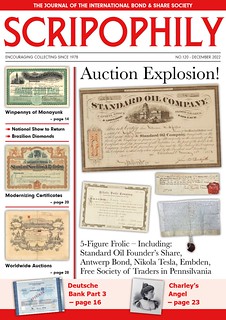 NEWS AND REVIEWS
NEWS AND REVIEWS
• Bits • Bang-Up Scripophily at Bonhams New York • Errata
• Banks In Transition: From Counters To Apps
... and more besides
EVENTS CALENDAR
COX'S CORNER
FEATURES
Deutsche Bank Part III: Shares in Deutsche Bank as a
Mirror of German Currency History
by Dagmar Schönig, (c) HIWEPA AG
W. Y. O. D. And Other Strange Mining Company Names
by James B. Copeland
Modernizing Certificates
by Mark D. Tomasko
Agua Suja Mining Co, Ltd – Diamonds in Brazil
by Rüdiger Hein
Charles Yerkes and the West Chicago Street Railroad
by Max Hensley
AUCTION NEWS AND REVIEWS
For more information on the International Bond and Share Society, see:
https://scripophily.org/
NNP ADDS JEFFERSON COMITIA AMERICANA LIST
The latest addition to the Newman Numismatic Portal is Thomas Jefferson's 1787 Comitia Americana medal list. Project Coordinator Len Augsburger provided the following report. -Editor
Thomas Jefferson's Comitia Americana List Available on NNP
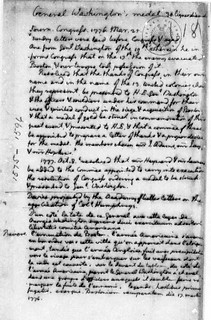 Courtesy of Roger Burdette, we have added a 1787 Jefferson memorandum that details the Comitia Americana medal set. Located in the Jefferson papers at the Library of Congress, the document appears new to this writer; although a sharp-eyed E-Sylum reader may likely note otherwise. In any case, Jefferson's Memorandum summarizes congressional resolutions for individual medals and describes the designs and mottos. Two medals from the Adams-Bentley list are unnoted, namely the Henry Lee and Diplomatic medals. The description for the FRANKLIN NATUS BOSTON medal indicates that COMITIA AMERICANA resides in the reverse exergue; on known examples it does not. Jefferson refers to the Libertas Americana as the
Courtesy of Roger Burdette, we have added a 1787 Jefferson memorandum that details the Comitia Americana medal set. Located in the Jefferson papers at the Library of Congress, the document appears new to this writer; although a sharp-eyed E-Sylum reader may likely note otherwise. In any case, Jefferson's Memorandum summarizes congressional resolutions for individual medals and describes the designs and mottos. Two medals from the Adams-Bentley list are unnoted, namely the Henry Lee and Diplomatic medals. The description for the FRANKLIN NATUS BOSTON medal indicates that COMITIA AMERICANA resides in the reverse exergue; on known examples it does not. Jefferson refers to the Libertas Americana as the Declaration of Independence
medal and does not identify Libertas Americana
as the obverse legend. Other discrepancies likely exist, and this document is worthy of further study.
Image: Libertas Americana medal in silver, PCGS CoinFacts plate image, courtesy of PCGS.
Link to Memorandum on Medals for George Washington, et al on NNP
https://nnp.wustl.edu/library/book/623925
Link to Library of Congress catalog record and document images:
https://www.loc.gov/item/mtjbib003223
What a great find! Interesting and important. -Editor
NEWMAN PORTAL CONGRESSIONAL DOCUMENTS
Newman Numismatic Portal Project Coordinator Len Augsburger provided the following report on the "Trillion-Dollar Coin" and NNP's collection of congressional documents. -Editor
The Trillion-Dollar Platinum Coin Sneaks Through
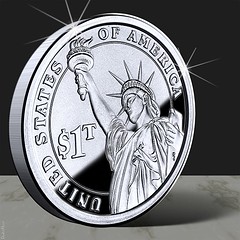 In 1996, the U.S. Congress passed Public Law 104-208, which states in part
In 1996, the U.S. Congress passed Public Law 104-208, which states in part The Secretary may mint and issue bullion and proof platinum coins in accordance with such specifications, designs, varieties, quantities, denominations, and inscriptions as the Secretary, in the Secretary's discretion, may prescribe from time to time.
The inclusion of the single word denomination
has given rise to all manner of speculation as to whether the Treasury department can legally strike a trillion-dollar coin. Congressional coin legislation is usually quite specific about denominations to be struck, and one can go all the way back to the Mint Act of 1792 on this point. Whether or not intended, the language of the 1996 statute leaves this question open.
Treasury Secretary Janet Yellen has called the trillion-dollar coin a gimmick
and noted that the Federal Reserve Bank would likely refuse the coin, should the Treasury attempt to deposit such a piece. For its part, the Mint continues to annually strike one-ounce platinum American Eagles, denominated as hundred-dollar coins.
In addition to Public Law 104-208, Newman Portal has built a collection of over 300 congressional documents related to numismatics. It's worth remembering that the Mint, and Bureau of Engraving and Printing, can act only in accordance with public law, and the related paper trail forms a useful research archive. NNP acknowledges Dan Hamelberg and Paul Hybert, both of whom have made extensive contributions to this collection.
We also wish to acknowledge Barbara Hofmann, Library Technical Specialist (Federal Documents) at Washington University in St. Louis. Washington University's Olin Library is designated as a Federal Depository Library, a program initiated by Congress in 1813 to ensure public access to government documents. As such, Olin Library holds an extensive collection of government publications, which Barbara has helped us navigate since Newman Portal was launched in 2014. Barbara has been with Olin Library since 1969 (not a typo!) and we wish her well on her upcoming retirement.
Link to Public Law 104-208 on Newman Portal:
https://nnp.wustl.edu/library/book/623082
Link to U.S. Congressional documents on Newman Portal:
https://nnp.wustl.edu/library/publisherdetail/512550
VIDEO: ROBERT LEUVER
The David Lisot Video Library on the Newman Numismatic Portal can be found at:
https://nnp.wustl.edu/library/multimediadetail/522852
We highlight one of his videos each week in The E-Sylum. Here's one from 1986 where David interviews ANA Executive Director Bob Leuver. -Editor
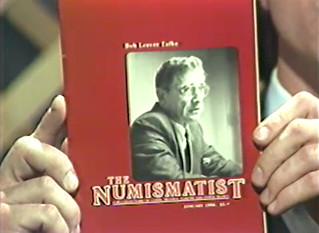 In this Collector Talk episode,
David Lisot travels to the headquarters of the American Numismatic Association and speaks with Executive Director Robert Leuver. Mr. Leuver is a former head of the Bureau of Engraving and Printing.
In this Collector Talk episode,
David Lisot travels to the headquarters of the American Numismatic Association and speaks with Executive Director Robert Leuver. Mr. Leuver is a former head of the Bureau of Engraving and Printing.
David interviewed Bob Leuver at the museum of the American Numismatic Association in Colorado Springs. He noted that the mission of the BEP is to print U.S. government security documents. They are not an appropriated entity - the BEP charges government customers for its products, which must be priced competitively with private industry. Their recent year's sales totalled $256 million.
One of Bob's accomplishments was improving outreach to collectors, attending shows, boosting souvenir card products and sales to numismatists, syngraphists, and philatelists alike.
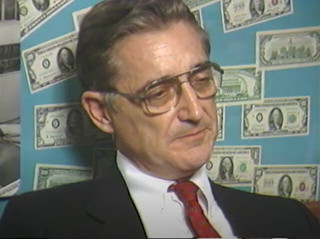 David asked about talk of discontinuing the dollar bill, but Bob didn't think it likely given the poor reception of the Susan B. Anthony coin. He acknowledged problems with the popularity of the
$2 bill and the issue merchants have with handling them, given that cash registers only have six compartments.
David asked about talk of discontinuing the dollar bill, but Bob didn't think it likely given the poor reception of the Susan B. Anthony coin. He acknowledged problems with the popularity of the
$2 bill and the issue merchants have with handling them, given that cash registers only have six compartments.
Bob dispelled rumors of a new "rainbow" currency but discussed other potential changes to counterfeit-proof paper money. Large increases were seen in counterfeiting in 1985 as printing technology got better and cheaper (including new digital scanners).
The BEP had recently donated an antique spider press to the ANA museum; Bob discussed plans for new web presses which would print even faster than the modern equipment currently in use. -Editor
To watch the complete video, see:
https://nnp.wustl.edu/library/book/584163
THE BOOK BAZARRE
JEFF GARRETT INTERVIEW, PART THREE
Here's the third and final part of Greg Bennick's interview with dealer and Redbook Editor Jeff Garrett, where the topic turns to great coins. -Editor
Greg Bennick: Tell me this, just shifting gears just slightly because I could talk about grading all day long. I'm always in a process of learning myself. But what are some of your favorite coins that you've handled out of the millions of coins or hundreds of thousands or whatever it is that pass through your hands every year? I mean, over time, what are some of your favorite coins that you've handled throughout your career?
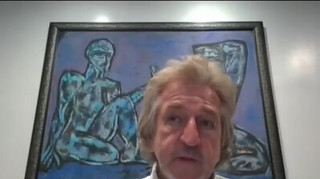 Jeff Garrett: You know, probably the most important collection that I ever had a chance to
handle that was just amazing from start to finish, I think it was about 15 years ago or maybe
a little bit longer, I lose track, it goes by so fast. But Bob Harwell in Atlanta, Georgia had a
client who had put together the finest collection of Dahlonega Gold and it was called the
Duke's Creek Collection. So, we bought a complete set of gold dollars, two and a halves,
threes and fives and he had a complete set of Templeton Reid gold coins. And I think it was
around $5 million, but probably three quarters of the coins were finest known for what they
are for the coin. So, it was an amazing collection of coins and we bought it and broke it up
and sold it to different people. Mark Salzberg actually still owns the set of $5 gold pieces. It
was sold to an investor at the time, and then somebody that Mark Salzberg knew and when
he had a chance to buy it about four or five years ago, he bought it intact. So the ones and
two and a halves got broken up and you still see the pedigrees occasionally. Don Kagan
bought the Templeton Reid gold, which is a two and a half, a five and a 10 and those are
mega rare and placed them with a client. But across the board, that was probably the neatest
collection I ever handled as far as being the finest known. And also I love US gold coins, it
was just really a distinct pleasure to own and have a chance to be involved in it.
Jeff Garrett: You know, probably the most important collection that I ever had a chance to
handle that was just amazing from start to finish, I think it was about 15 years ago or maybe
a little bit longer, I lose track, it goes by so fast. But Bob Harwell in Atlanta, Georgia had a
client who had put together the finest collection of Dahlonega Gold and it was called the
Duke's Creek Collection. So, we bought a complete set of gold dollars, two and a halves,
threes and fives and he had a complete set of Templeton Reid gold coins. And I think it was
around $5 million, but probably three quarters of the coins were finest known for what they
are for the coin. So, it was an amazing collection of coins and we bought it and broke it up
and sold it to different people. Mark Salzberg actually still owns the set of $5 gold pieces. It
was sold to an investor at the time, and then somebody that Mark Salzberg knew and when
he had a chance to buy it about four or five years ago, he bought it intact. So the ones and
two and a halves got broken up and you still see the pedigrees occasionally. Don Kagan
bought the Templeton Reid gold, which is a two and a half, a five and a 10 and those are
mega rare and placed them with a client. But across the board, that was probably the neatest
collection I ever handled as far as being the finest known. And also I love US gold coins, it
was just really a distinct pleasure to own and have a chance to be involved in it.
Greg Bennick: Are there any coins that you wish you handled? Meaning the one that got away, those sorts of things? I know that I've got a few of my own certainly, but I'm really curious to know about yours.
Jeff Garrett: Yeah, you know what's funny, it's like this 1919 penny kind of brings it to mind. If I had to go back in time and tell my younger self, I would've said how many times did I own like a 1945 dime in MS-68 that I probably sold for $30? If I'd had any idea or an inkling that thirty years later people would pay insane money for relatively modern coins, like a set of Lincoln pennies or Jefferson nickels and things like that. So they might not have been the most interesting, but I wish I'd have had the foresight to understand superb gems. And there's been some people who have done that back in the day, we all thought they were almost kind of crazy. They would pay like crazy money for a coin because it was like, oh, it had unbelievable toning , they pay $300 for Morgan dollars. Like, oh, that's crazy and now those are $30-40,000. So probably going back in time, I'd let a lot of really great superb coins slip through my fingers that I sold that probably, if I had any foresight at all, I probably would've kept them.
Greg Bennick: So here's an interesting question that just came to mind. What are those coins
now? Meaning that certainly thirty years from now, people will be sitting around, maybe 50
years from now, they are going to be sitting around thinking, Man in 2022, 2023, we had
the chance to buy…. blank….and we just let it go cause we thought it was overpriced then.
There's always that situation, like if you asked my dad, he'd say sure, an 1856 Flying Eagle
was cheap when he was coming up collecting, but who had the money to buy that?
Regardless of how cheap
it was compared to modern standards. What do you think those
coins are now? I know that's speculative and I know you're not giving investment advice….
Jeff Garrett: Yeah, well I had a conversation like this just recently with a friend and I told
him about…it goes back to what I told you originally about the coin business, it is about
supply and demand. So, if somebody came in and said I really want to buy coins…but I
want to learn about them.
I always tell people don't buy anything for an investment. You
know, try to learn about it and become a collector because you have a much better chance.
But the idea that if you buy the keys for almost every series and I talked to someone the day,
a good friend of mine, Rollo Fox, up in Louisville. He put together a complete set of Double
Eagles. He started putting it together and he realized that, you know, you get to this must-
have mentality and you gotta pay a lot of money to get a certain date or whatever. But he said
that now he collects coins by what he calls The Box of 20
. So, he'll buy like a really nice
coin and that's how he collects now. He doesn't collect by series. He collects one really nice
grade coin.
So, I think in the long run, 40, 50 years from now, you know, an 1881-S Morgan Dollar, I don't care how good you think it is, it's still going to be a common coin because there's tens of thousands of them out there. But an 1889 CC dollar in MS-63, that's a good coin. And if the numbers of collectors grow, theoretically there's going to be more people collecting Morgan dollars and they're going to need those key dates. So, I think the supply and demand factor, if you think about it, the focus on key coins regardless of the series or regardless of the country or ancient coin, modern coin, whatever it is, I think that you have the leverage of demand that'll always be in your favor. And that's what I would think is a good idea.
Greg Bennick: Speaking of, what did it feel like when you bought the 1913 Liberty nickel. I've seen the video and you were very, what's the word, understated in that moment? If it was me, I would've done a backflip off the chair and I would've been screaming and yelling. You were very understated, very calm. What did it feel like to buy the 1913 Liberty nickel?
Jeff Garrett: Well, it was more of like a shock moment because…I've written a couple
articles about it, but I didn't know I was going to buy that coin earlier in the day. I called my
good friend Larry Lee, who I knew had a couple of big clients. I said, Larry, there's a 1913
nickel coming up, but it might sell reasonably.
That coin is kind of funny. It's such a great
classic coin, but now it's not even close as far as the most valuable coin. That's because so
many other coins have shot up above it, but it still has the best story. It's still iconic. I said,
Larry, this might slip through the cracks.
So, an hour or two before the sale, he didn't
return the call all day and then eventually he called me an hour or two before the sale and he
says, What do you think it'll bring?
I think I said, It'll bring under 4 million. I think it'll be
probably a little over three.: And we just talked about it for a while and he said,
Well let's
bid this….
And so I said I'll take a certain percentage…you do that. And then we went to
the sale and then all of a sudden, you know as you've seen the video, it was sold. And it was
kind of shocking, it was like, Oh my gosh, I can't believe this happened
and we bought it.
I did tell someone, it's interesting lately we've been talking about, it's kind of sad that because
of the pandemic, auctions now have been driven all online. And that was probably one of the
last…well there's been a few instances lately, you know, The Bass sale they did live and had
some clapping, but still not like this was. There were hundreds of people in the room.
Hundreds. And when the coin went off, it was a roar of applause. I go outside, the press was
there, I get interviewed. Now a coin sells for $8 million, and it's like, Okay.
You know, a
little bit like that…then the next lot. The drama of the grand auction room is really lost to us.
And that's really kind of a sad thing because it really was exciting. And you know, it wasn't
the biggest deal I've ever done in my career, but it was probably one of the more exciting
deals I've done. And it was one that I'll always kind of cherish the evening. My son was
sitting next to me when we did it, and it was a lot of fun. He had no idea I was even bidding.
He was like, What? What are you doing?
And it was something I'll always remember.
And I can't even believe how fast time goes by, but this year, the Central State's show that's
coming up, it'll be 10 years now. It'll be 10 years ago that we did that, so I know it went by
pretty quickly.
Greg Bennick: Yeah, time just flies. That's amazing. And there is something about the live auction room that just can't be replicated. I mean, there's just an energy. I remember years ago, I flew to Baltimore. I'm from Seattle, and I flew to Baltimore to bid on an error coin. It was a counterbrockage Liberty, nickel, and I had wanted this coin forever. And I flew there and my dad met me. We went to the auction. To make a long story, very short, I bid on the coin and I think my palms are sweating even now, remembering how much my palms were sweating and the energy of it and the entire experience was just transformative. So that's why I had to ask, having seen that video of you.
Jeff Garrett: Yeah. And it's such a shame that it's not really how it works anymore. It's so much more transactional now than it is or is like an experience, you know, something that you would remember and have fun doing it. One of my favorite auction stories of all time was John Jay Pittman when there was an 1854 Gold dollar in proof that he knew how rare it was. He was famous for being really knowledgeable back in the sixties and it came up for auction. It's famously called the Statue of Liberty coin. And he went to the front of the room and stood there with his hand up, like the Statue of Liberty facing down on anybody who was bidding against him, and he bought the coin. And that coin was famous always for that, the Statue of Liberty coin, he wasn't going to let anybody outbid him, but that's how he did. And I had the privilege of handling that coin about 10 years ago, I sold it to, well maybe less than that, to Del Loy Hansen, the billionaire collector. So, I got to sell that coin; it was a lot of fun.
Greg Bennick: That's amazing. That must have been a very intimidating moment if somebody had flown to proverbially Baltimore to bid on the coin and then Pittman standing in the front of the room like the Statue of Liberty. That's an amazing moment.
Jeff Garrett: Yes facing the audience. It was pretty funny.
Greg Bennick: Now last question, and you've been really generous with your time, and I don't want, as I ask this, to make it sound like you've been in the business so long that I need to ask a historical question. Don't take it that way, you're certainly not a dinosaur and I'm excited that you're here just answering all these questions with me today, it's just amazing. But when you started, there were some of the old timers…were certainly were still around. Who were the characters that you remember? I'm always fascinated by numismatic history and who were some of the old timers that you remember who maybe aren't with us anymore, who were real characters? You know, just a story that pops into your head about like the Pittman story, for example.
Jeff Garrett: Well, it's funny. So I mentioned to you earlier: I grew up in Clearwater, Florida, so I had the luck. In 1974, when I was 16, the ANA convention was in Miami. And I'd never been to Miami. I hadn't really traveled much. And one of the coin dealers volunteered to take me down there and escort me down there. And I went down to the 1974 ANA and it was at the Fountainbleu. I recently stayed there with my wife. And it was kind of fun to see the old hotel, the site of the 1974 ANA and one of the vivid memories I have was…Abe Kosoff was there and that was very late. I'm not sure he lived a whole lot longer after that, but he was there and he had two showcases. He had a showcase on the right and one on the left. And in one showcase he had an ultra high relief Double Eagle, 1907 Ultra High Relief. It had recently sold for around a hundred thousand dollars, it kind of broke a new price record. And in the other case he had a mint condition Syracuse Dekadrachm, which I don't know what it was at the time. Those are both crazy coins to me at the time. But it was funny, he was dressed in a white summer suit and he was such a striking character. And I just remember seeing Abe Kosoff at his table and I was like wow, that was pretty cool to see and I still remember that. And that was my first ANA show in 1974 and luckily I've had the chance to go to every ANA convention since. I haven't missed one since 1974. So I've got a string going.
I'll tell you a funny story, it's not about a character, but the 1975 ANA was in Los Angeles, which for a 17 year old kid in Florida, it could have been on Mars. It was like forever. That was a long ways away. I didn't have any money at the time and I was like gosh, I'd really like to go to that show. And I went to my local Clearwater Coin Club and there was one of the great characters at the time, was a guy named Colonel Jeffries, which people who grew up in that area probably know him. He was a really crazy character and he had an 1839 half dollar for sale and he sold it to me and it was mint condition, but he didn't realize it was a No Drapery and it was like something I'd studied. I realized it and I bought it. I think I made like $500 on it. And that gave me the money to go to the 1975 ANA in Los Angeles. So, it was really funny, my little pickoff of a variety helped me go to that next coin show. And over the years I've really been lucky, I've got to know so many of the great characters in the business. I mean, there have been so many colorful people. I remember in my area there was Robert Hendershot, he was a great character. I'm not sure if you knew him back in the day.
Greg Bennick: I know the name, yeah.
Jeff Garrett: Yeah, he lived to…I think he was 106 or so…kind of like Eric Newman did. And he went to the 1904 Louisiana World's Fair and he wrote a book about that later on because he was a big collector of those. And I remember buying great coins from him and some of the characters. Some of the guys that I really miss the most that became mentors was David Akers, was a really wonderful guy. He had an unbelievable memory buying coins, telling me stories from the fifties and sixties. He was always sharing with me. He was a mentor and I learned a lot from him and it really great. Even now, I consider Dave Bowers one of the great characters of all time. I consider myself lucky to call him a friend. The things he shared with me and some of the stories. But I'd have to make a list. I've really been lucky because I've done coins at the level where I got to know a lot of the great people. And it's been a lot of fun, but I'll never forget Abe Kosoff in his white suit, that's probably the most vivid one from my early years.
Greg Bennick: That's fantastic. Well, I know that we've been on for near nearly an hour, so I just want to thank you for your time and those are the questions that I'd prepared. I'm sure I could come up with a hundred more, but I really appreciate you taking the time to answer them. I appreciate Newman Numismatic Portal being willing to support what's going to be a series of interviews that I'm going to do with folks. And of course, I appreciate everybody watching. This has been really fantastic. Thank you so much.
Jeff Garrett: Oh, happy to do it. And I'm really happy with Newman Numismatic Portal because as we talked about it, numismatic education is the key to being a successful collector. So, people should utilize it as much as they can.
Greg Bennick: Awesome. Well, thank you so much.
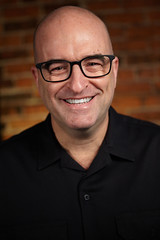 About the Interviewer
About the Interviewer
Greg Bennick (www.gregbennick.com) is a keynote speaker and long time coin collector with a focus on major mint error coins. Have ideas for other interviewees? Contact him anytime on the web or via instagram @minterrors.
To watch the complete interview on NNP, see:
Jeff Garrett, Interviewed by Greg Bennick
(https://nnp.wustl.edu/library/book/622304)
To read the earlier E-Sylum articles, see:
JEFF GARRETT INTERVIEW, PART ONE
(https://www.coinbooks.org/v26/esylum_v26n07a13.html)
JEFF GARRETT INTERVIEW, PART TWO
(https://www.coinbooks.org/v26/esylum_v26n08a07.html)
RALPH W. ROSS, A ST. ELIGIUS KNIGHT
Editor Judy Blackman published an article in the March 2023 issue of the Nashua Coin Club's publication the Nashua Numismatist about ANA President Ralph Ross and his family titled "Did you know a St. Eligius Knight leads the ANA?" With permission, we're publishing an excerpt here. Thank you! -Editor
This is a personal story of Ralph W. Ross, PhD, President of the American Numismatic Association (ANA) and a Knight of St. Eligius. To be a Knight, you must be a kind, generous, caring person focused on advancing the studies of numismatics, growing the hobby, and building fellowship. Dr. Ross is a role model in this regard. I hope you will feel the same pride that I do, when you are done reading, knowing that such as person is leading one of the largest numismatic organizations in the world! I am thankful to Dr. Ross and his family, for affording me time in the fall of 2022, to complete this story.
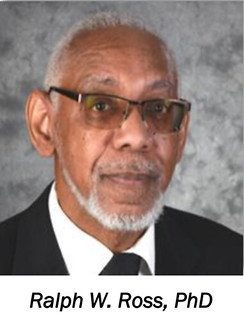 With the recent induction of Dr. Ralph W. Ross, PhD, as a Knight of St.
Eligius, as a fellow Knight, I want to celebrate his glory. Also 2022 is a
special anniversary for Ralph in terms of numismatics! Unlike, most articles
published about Ralph W. Ross, PhD, this story of Dr. Ross will lean towards
a more personal insight to the man — whose family lovingly calls him
With the recent induction of Dr. Ralph W. Ross, PhD, as a Knight of St.
Eligius, as a fellow Knight, I want to celebrate his glory. Also 2022 is a
special anniversary for Ralph in terms of numismatics! Unlike, most articles
published about Ralph W. Ross, PhD, this story of Dr. Ross will lean towards
a more personal insight to the man — whose family lovingly calls him the
genius
— a devoted spiritualist, loving father, devoted husband, outstanding educator, renowned professional, fully-engaged hobbyist, and all-around
nice person. Ralph's daughter Jillian notes, Our summer vacations were
planned around ANA National Conventions in cities around the United
States, at times bringing along my father's siblings and their families, and
this included attending the ANA banquets too.
Let's first get the résumé covered that most articles are focused on. It's convenient where Ralph and his lovely wife Phyllis A. Ross live in Sugar Land, Texas. Ralph spent nearly two years in the National Aeronautics Space Administration (NASA) —Occupational Health and Human Test Support. This came after his work with GTE as Assistant Engineer and GSI as a Seismologist. These three roles were in conjunction with his teaching career and advancing his own education. First came his Bachelor of Science (Mathematics, Chemistry), then his Master's degree (Mathematics), and over the course of 32 years, Ralph completed his Doctorate (Environmental Toxicology). It's important to remember Ralph and Phyllis started a family going on to raise three children during this period (Jason, Jeremy, and Jillian).
Ralph's professional teaching career began in 1980 as a Graduate Teaching Assistant with the University of Michigan. His teaching profession has spanned over 40 years, teaching Mathematics, Physics, Chemistry and other subjects.
Ralph grew up in Muskegon (Michigan), and later moved to Houston (Texas) in 1982 where he met and married his wife Phyllis and started a family. Ralph's introduction to numismatics is a bit unusual from most stories, and it may also have triggered his interest in mathematics as well. He lived across the street from Coleman's Grocery which had candy machines out front, with the gumball machine being a favourite since his older brother Sam taught him how to use it. When Ralph thought the gumball machine broke, the store owner Mr. Coleman showed him that the machine could not accept Ralph's coin, as it was a 12-sided (dodecagon 1951) Canadian 5-cent piece rather than a round US Buffalo-nickel, but Coleman offered to exchange the coin.
Ralph however, had a different idea, he ran home to his mother. To calm the disappointed 4-year-old, Ralph's mother explained to him about currency used in countries outside the USA, such as the
Canadian 5-cent piece. At his mother's urging, Ralph saved the Canadian coin. Ralph shares, From that day on, I have
collected various things, such as bottle caps, baseball cards, marbles, stamps, spiders (live), lottery tickets, and of
course, coins of all kinds.
Somewhere in his life, Ralph also became a fan of jazz music, travelling, and sports (he is the
proud great-uncle of NBA Boston Celtic All-Star Jaylen Brown).
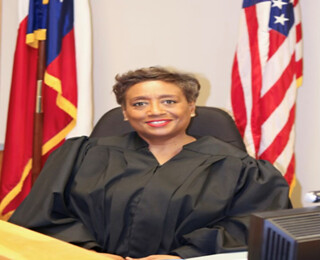 The Honorable Phyllis A. Ross, a Presiding Municipal Court Judge in Suburban Houston, Texas is a
graduate of the University of Texas at Austin and the University of Houston Law Center. Judge
Ross grew up in Dallas, Texas and has practiced law in the Houston community since 1992.
Judge Ross is married to Dr. Ralph Ross, a mathematics professor, and they are the parents of
three children, and the grandparents of three. Judge Ross has
been instrumental in the lives of her children and others, serving
as a college prep consultant and mentor helping young people
achieve their dreams. Judge Ross shares the successes learned
in helping her children excel and encourages students and
parents to strive for excellence. Judge Ross and her husband,
the owner of Ross Family Coins and President of the American Numismatics Association, travel the country attending local, state, regional, national and international coin
shows and encouraging young numismatists. Judge Ross is active in her community
and has served as a volunteer for Girl Scouts of America, her church and other
organizations, and is an active member of Delta Sigma Theta Sorority.
The Honorable Phyllis A. Ross, a Presiding Municipal Court Judge in Suburban Houston, Texas is a
graduate of the University of Texas at Austin and the University of Houston Law Center. Judge
Ross grew up in Dallas, Texas and has practiced law in the Houston community since 1992.
Judge Ross is married to Dr. Ralph Ross, a mathematics professor, and they are the parents of
three children, and the grandparents of three. Judge Ross has
been instrumental in the lives of her children and others, serving
as a college prep consultant and mentor helping young people
achieve their dreams. Judge Ross shares the successes learned
in helping her children excel and encourages students and
parents to strive for excellence. Judge Ross and her husband,
the owner of Ross Family Coins and President of the American Numismatics Association, travel the country attending local, state, regional, national and international coin
shows and encouraging young numismatists. Judge Ross is active in her community
and has served as a volunteer for Girl Scouts of America, her church and other
organizations, and is an active member of Delta Sigma Theta Sorority.
We thank Ralph and his entire family for the wonderful impact they have had on the hobby of numismatics, and how they continue to embrace everybody they meet with pureness of heart. It's easy to see why Dr. Ralph W. Ross was inducted on 11 December 2021 into the St. Eligius Numismatists Brotherhood of USA. He is certainly a role model for how all St. Eligius Knights lead. May St. Eligius continue to guide your path!
2022 Royal Canadian Numismatic Association convention in Ottawa, Ontario, Canada, and it shows four Knights of St. Eligius, including (left to right) Scott E. Douglas, the Grand Chancellor of the Brotherhood of St. Eligius Knights-Canada; Phyllis, Ross, and Serge Pelletier, RCNA NumisNotes Editor
To read the complete issue, see:
https://0n.b5z.net/i/u/10244551/f/Nashua_Coin_Club-Mtg_Mar_2023-Min_Feb_2023-finalized-v2.pdf
Judy adds:
"NCC just completed a series of interviews of NCC members of those who were willing to be interviewed. Starting with the January 2021 issued up to and including Dec. 2022 issue, 41 interviews were conducted and the resulting stories published in the Nashua Numismatist. These stories helped the club members' bond grow tighter as members discovered more common backgrounds and interests, and some surprises in the process. It may be an exercise other clubs wish to try!"
Indeed - great idea and project! -Editor
For more information on the Nashua Coin Club, see:
https://nashuacoins.com/nashua-coin-club/
BAKER'S BOOK ON WILLIAM SHARP, ENGRAVER
Inspired by last week's Newman Numismatic Portal report by Len Augsburger, NBS President Tom Harrison passed along an additional important book authored by William S. Baker. Thank you! -Editor
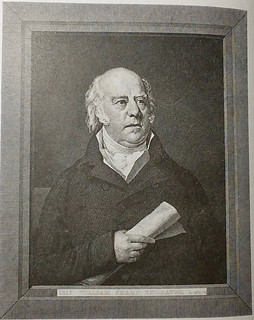 An additional William S. Baker's authored work is titled "William Sharp Engraver With A Descriptive Catalogue Of His Works". Sharp was born in London January 29th, 1749 and died at Chiswick July 25th, 1824. The rather obscure book has red pebbled cloth, 231 pages and a frontispiece portrait of Sharp dated 1817. In the first part of the book Baker presents a 30 page brief overview of Sharp's life and then highlights a number of his engravings. The second part gives a descriptive list of his 231 engravings. While the book's major numismatic connection is the author, it should be noted he engraved portraits of George Washington, Commander in Chief and Matthew Boulton. Baker praised Sharp's talent saying, "William Sharp stands unrivalled in the English, and the equal of the best portrait engravers of any school." This particular volume is inscribed on the half-title page "Clarence S. Bement from W.S. Baker". Today Bement is remembered for the quality and scope of his collection that was sold at auction by Henry Chapman.
An additional William S. Baker's authored work is titled "William Sharp Engraver With A Descriptive Catalogue Of His Works". Sharp was born in London January 29th, 1749 and died at Chiswick July 25th, 1824. The rather obscure book has red pebbled cloth, 231 pages and a frontispiece portrait of Sharp dated 1817. In the first part of the book Baker presents a 30 page brief overview of Sharp's life and then highlights a number of his engravings. The second part gives a descriptive list of his 231 engravings. While the book's major numismatic connection is the author, it should be noted he engraved portraits of George Washington, Commander in Chief and Matthew Boulton. Baker praised Sharp's talent saying, "William Sharp stands unrivalled in the English, and the equal of the best portrait engravers of any school." This particular volume is inscribed on the half-title page "Clarence S. Bement from W.S. Baker". Today Bement is remembered for the quality and scope of his collection that was sold at auction by Henry Chapman.
To read the earlier E-Sylum article, see:
GEORGE WASHINGTON TRIBUTES
(https://www.coinbooks.org/v26/esylum_v26n08a04.html)
COIN BAGS OF THE WORLD
E-Sylum advertiser NumismaticWholesale.com writes:
"Being in the wholesale collectibles business for 55 or so years, we kept many bags, boxes, bands, wrappers etc. Here pictured, are some examples."
Thanks - these are great! -Editor
To read the earlier E-Sylum article, see:
AN ESSAY ON COIN BAGS
(https://www.coinbooks.org/v26/esylum_v26n08a14.html)
NOTES FROM E-SYLUM READERS: FEBRUARY 26, 2023
BS and SCAMS Grading Systems
Pete Smith's article on Coin Bags had a humorous take on the topic of grading.
Fred Schwan writes:
"I wrote a trilogy of articles for Numismatic News in the 1980s regarding grading. I cannot remember the name of the first one, but the idea was that since every coin is different, every one should be assigned a different grade which would be the equivalent of a serial number. The owner would be issued a certificate and the coin deposited under Cheyenne Mountain. The certificates could then trade. An updated article would propose images on the internet allowing a collector to actually see the coin.
"The second article was the BS grading system. I remember one line from the article of which I was particularly proud. I suggest that a VG bag may have been laundered and if it had not been, it probably should be.
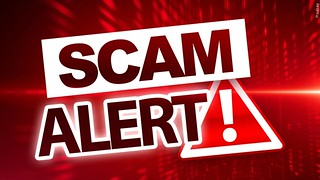 "The third article was intended to be the culmination of the series. It was about SCAMS--Scientific Coin Analysis and Marketing System. The heart of this was vending machines. Of course these machines were capable of grading coins on the spot. Furthermore, franchises were available for sale.
"The third article was intended to be the culmination of the series. It was about SCAMS--Scientific Coin Analysis and Marketing System. The heart of this was vending machines. Of course these machines were capable of grading coins on the spot. Furthermore, franchises were available for sale.
"I doubt if anyone remembers these stories. That is of course because it was a long time ago, but also because the SCAMS article was never published. Political correctness seems to have existed even then!"
You were always ahead of your time, Fred. -Editor
To read the earlier E-Sylum article, see:
AN ESSAY ON COIN BAGS
(https://www.coinbooks.org/v26/esylum_v26n08a14.html)
What the Milholland Collection Reveals
Max Hensley writes:
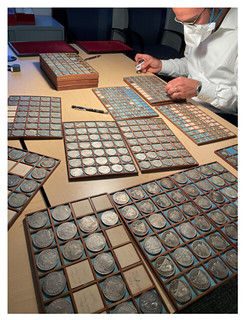 "Thanks for including the article on the Milholland sale by Stacks. That was very interesting. I was particularly intrigued by the non-proofs as these were representative of what could be obtained by collectors in the day out of circulation or from the limited number of dealers/auctions. There was a definite decline in the condition curve as the pieces got older. The evidence of what was available in the east regarding mint-marked coins was interesting too - almost no San Francisco coins, and the ones that were included were heavily worn. More New Orleans pieces made it, a few more in the middle. The mint data showed that the migration of coinage was very slow in those days."
"Thanks for including the article on the Milholland sale by Stacks. That was very interesting. I was particularly intrigued by the non-proofs as these were representative of what could be obtained by collectors in the day out of circulation or from the limited number of dealers/auctions. There was a definite decline in the condition curve as the pieces got older. The evidence of what was available in the east regarding mint-marked coins was interesting too - almost no San Francisco coins, and the ones that were included were heavily worn. More New Orleans pieces made it, a few more in the middle. The mint data showed that the migration of coinage was very slow in those days."
Great observations - thanks. -Editor
To read the earlier E-Sylum articles, see:
THE JAMES ALLAIRE MILLHOLLAND COLLECTION
(https://www.coinbooks.org/v26/esylum_v26n08a17.html)
JAMES ALLAIRE MILLHOLLAND (1842 - 1911)
(https://www.coinbooks.org/v26/esylum_v26n08a18.html)
More on the Warren Harding Inaugural Medal
"I'm sorry but I can't add anything about this medal. I have never seen this piece and didn't have the dies for it. Schwaab made exonumia for events all over the country. It is a badge medal which would have been attached to a pin bar and worn. Possibly the Republican Party of which Harding belonged to, had these made to hand out to the dignitaries attending the inauguration. "
Heath White writes:
"I'm no help on value, but expect it is nominal. The reverse die for the Lord's Prayer and the hob to make the WGH bust die still exist. Nothing else I can think of to help with provenance from Schwaab perspective.
There is at least one that sold on eBay. The same WGH hob appears to have made this too."
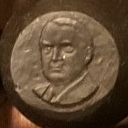
Thank you. Heath provided this image of the Harding portrait hob. -Editor
For information on Worthpoint, see:
RAREHTF 1921 WARREN G HARDING PRESIDENT POLITICAL REPUBLICAN MEDAL INAUGURATION
(https://www.worthpoint.com/worthopedia/rarehtf-1921-warren-harding-president-3243711745)
WARREN G. HARDING INAUGURATION SOUVENIR MAR. 4 1921 PIN
(https://www.worthpoint.com/worthopedia/warren-harding-inauguration-souvenir-4552558390)
To read the earlier E-Sylum article, see:
NOTES FROM E-SYLUM READERS: FEBRUARY 19, 2023 :
Query: Warren Harding Inaugural Medal
(https://www.coinbooks.org/v26/esylum_v26n08a09.html)
Medallic Art Exhibit: Progression
Mashiko is in Kyoto, Japan with a traveling exhibit, Progression. -Editor
The Medallic Art is created in various materials; metals, woods, urushi, and glass. It is not yet familiar art format in Japan. Contrary, abroad, medals are a known art and collectable. Planned as a traveling exhibit, Progression started at Medialia…Rack and Hamper Gallery, in New York, in 2019. Postponed by the pandemic, at long last Progression opens in February 2023, at Galarie h20, in Kyoto. With nineteen Japanese and nine Portuguese artists, along with one New Zealand artist as a guest participant in the Japanese group, the exhibition is co- organized by Mashiko and José Simão
The medallic art is known as a monument-in-the-palm. I hope you enjoy the exhibition.
Tsutomu Ohmukai, the Director of Galarie h20
For more information on Mashiko's Medialia…Rack and Hamper Gallery, see:
http://medialiagallery.com/
A COIN POSTCARD ALBUM
Sally T Davies of the UK writes:
"I recently came by this album of coin postcards and thought you or your readers might be interested to see some images. Together with the 45 postcards, which I believe is a complete set, was a contemporary guide to using the postcards as a reference source for exchange rates.
"The cards appear to have been collected from different sources and have various identifying marks such as Printed in Bavaria, Printed at works in Saxony, and Made in Germany. I've yet to examine them all ."
Thank you. We've published examples of the postcards before, but I don't believe we've seen this text. -Editor
Sally adds:
"There is no card for Canada which I would have expected. It seems like it's a rare one as one selling site has multiple cards for sale all around $10 and a Canada one for $374. Would you have any idea why Canada would not be included in the original sets?"
Sally continues:
"Here's a complete list of the cards, as you can see, two countries have two cards each. It may explain why a country might be missing, I'm not sure if the original sets were 45 cards or 45 countries."
| A-M | M-Z |
|---|---|
| Argentina
Austria Belgium Brazil Bulgaria Chili (sic) China Denmark Ecuador Egypt Finland France Germany German East-Africa German New Guinea Great Britain and Ireland Greece Hungary Japan - 1 rin , 1 sen to 1 yen Japan 2 to 40 new yen India and Ceylon Italy Marocco |
Mexico
Netherlands Netherlandish India Norway Persia Peru Portugal Roumania Russia Serbia Siam Spain Straits - Hong Kong Sweden Switzerland Transvaal Tunis Turkey - gold and silver coins Turkey - other coins United States Uruguay Venezuela |
To read the complete sale listings, see:
Coin & Currency Postcards
(https://www.oldpostcards.com/coin-postcards.html)
Canadian, Super Rare, Very Hard to Find, Canada Coin Postcard
(https://www.oldpostcards.com/c/con002129-canadian-very-rare-very-hard-to-find-canada-coin-postcard.html)
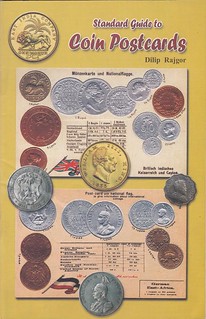 I don't know about the Canada card, but we do have some good information in the earlier E-Sylum articles which mention complete sets as having 43, 45 and 46 cards at various times.
The best source of information may be the Standard Guide to Coin Postcards published in India in 2011. I don't have a copy.
-Editor
I don't know about the Canada card, but we do have some good information in the earlier E-Sylum articles which mention complete sets as having 43, 45 and 46 cards at various times.
The best source of information may be the Standard Guide to Coin Postcards published in India in 2011. I don't have a copy.
-Editor
To read some earlier E-Sylum articles, see:
NUMISMATIC POSTCARDS
(https://www.coinbooks.org/esylum_v08n02a14.html)
COIN CARD POSTCARD ALBUM CENSUS
(https://www.coinbooks.org/esylum_v17n02a29.html)
MORE ON NUMISMATIC POSTCARDS
(https://www.coinbooks.org/esylum_v17n04a19.html)
BOOK REVIEW: STANDARD GUIDE TO COIN POSTCARDS
(https://www.coinbooks.org/esylum_v19n41a05.html)
2023 ROCKWELL LECTURE: SYDNEY F. MARTIN COLLECTION
John Ferreri passed along this announcement for the next Boston-area lecture in honor of Thomas P. Rockwell. -Editor
Tuesday, April 11, 2023 at 7:30 p.m.
Sponsored by:
Boston Numismatic Society, Currency Club of New England, and Collectors Club of Boston.
This year we are pleased to announce that Mr. Kevin Vinton will be speaking on The Coins, Tokens, Medals, and Paper Money of Early America as seen through the Sydney F. Martin Collection
.
Kevin was born and raised in Connecticut and was introduced to coins at an early age by his parents who were both collectors. He is a life member of the American Numismatic Association, Early American Coppers, the Colonial Coin Collectors Club and many other organizations. He is an instructor on early American copper coins at the ANA Summer Seminar and cataloged the annual Early American Coppers auction from 2015-2021.
He is a contributor to A Guide Book of United States Coins and to the Whitman Encyclopedia of Colonial and Early American Coins. As an author he has won awards for articles published in The Numismatist and the Penny-Wise journal. Kevin lives in Massachusetts with his wife and three children where he is employed as a senior numismatist for Stacks/Bowers Galleries in Boston.
Please join us at the New Light Korean Church 730 Main St (Rt.20) Waltham for an informative and enjoyable evening. The program will commence at 7:30 pm, the building will be open to socialize at 6:30 pm. In addition to the church, there should be sufficient on-street parking and across the street at the Waltham Library (after 6 PM). For further information please contact William Harkins at (617) 459-3975 or williamharkins@comcast.net.
"Once a year the three clubs mentioned together sponsor the Rockwell Memorial Lecture in honor of Thomas P. Rockwell a member and mover in each of these three clubs. Tom passed away in 2012 at the age of 95. The three clubs sponsor this "Lecture" in his memory. "
HANNA ANTONINA JELONEK RECEIVES SALTUS AWARD
The ANS has announced Hanna Antonina Jelonek as its latest J. Sanford Saltus Awardee. -Editor
Hanna Antonina Jelonek receives the American Numismatic Society's 2022 J. Sanford Saltus Award for Excellence in Medallic Art
 The American Numismatic Society is pleased to announce that Polish sculptor Hanna Antonina Jelonek is the recipient of the Society's prestigious 2022 J. Sanford Saltus Award for Signal Achievement in the Art of the Medal.
The American Numismatic Society is pleased to announce that Polish sculptor Hanna Antonina Jelonek is the recipient of the Society's prestigious 2022 J. Sanford Saltus Award for Signal Achievement in the Art of the Medal.
A lifelong student of the arts, Jelonek studied at the Faculty of Painting, Graphics and Sculpture at the State High School of Fine Arts in Wroclaw before completing her MA at the Academy of Fine Arts in Warsaw. She graduated with honors in 1981 with a specialty in medallic art under the supervision of Prof. Zofia Demkowska.
In 1985–86, she held a scholarship from the Italian Government to continue her studies at the School of Medallic Art in Rome (Scuola dell'Arte Della Medaglia presso la Zecca Romana), receiving the Commendation of the School Council.
Since 1990, she has held several positions at her alma mater, the Academy of Fine Arts in Warsaw, in the Department of Sculpture, beginning as an assistant in the Studio of Medals and Small Sculpture Forms, run by Prof. Piotr Gawron. In 1998, she received her PhD in Fine Arts from the Academy, habilitated in 2005, and became a full professor in 2020. From 2012 to 2019, she served as Dean of the Faculty of Sculpture, and, since 2004, has been running the Medallic Art Workshop.
Aside from her academic and educational accomplishments, Jelonek is a prolific sculptor and medallic artist and has participated in many exhibitions and national and international competitions. Her works are in the collections of, among others, the Medal Art Museum in Wroclaw, the Copper Museum in Legnica, the Asia and Pacific Museum in Warsaw, and the British Museum. Her awards include, among many others, the 2018 British Art Medal Society's Struck Medal Award.
Saltus Committee chair Alan Stahl noted that the Saltus Committee singled out Hanna Jelonek from a strong field of contemporary medalists for her ability to explore such modern techniques in medallic art as the use of negative space and multiple materials while at the same time showing herself a master of the classic elements of psychological portraiture and the expert use of lettering to complement the sculptured images.
An award ceremony is planned to take place at the ANS headquarters in New York City on Thursday, October 5, 2023. More information on the event will be provided closer to the date.
The award was created with a grant to the American Numismatic Society by J. Sanford Saltus in 1913 to recognize and encourage excellence in the art of the medal. The first Saltus Award was presented in 1919; the silver award medal was designed by the prominent German-born numismatic and architectural sculptor Adolph Alexander Weinman.
Jelonek joins the ranks of other significant artists who have been awarded the medal including, among dozens of others, James Earl Frazer (1919), Victor D. Brenner (1922), Paul Manship (1925), Lee Lawrie (1937), Donald DeLue (1967), Kauko Räsänen (1986), João Duarte (2011), and two other Polish recipients, Ewa Olszewska-Borys (1993), and Pawel Leski (2014).
To read the complete article, see:
Hanna Antonina Jelonek receives the Saltus Award
(https://numismatics.org/hanna-antonina-jelonek-receives-the-saltus-award/)
JOHN SAUNDERS APPOINTED TO CCAC
John Saunders is the newest member of the U.S. Mint's Citizens Coinage Advisory Committee (CCAC). -Editor
The United States Mint today announced the appointment of John Saunders to the Citizens Coinage Advisory Committee (CCAC) for a statutory four-year term. Mr. Saunders was appointed by Treasury Secretary Janet Yellen based on the recommendation of the Minority Leader of the U.S. House of Representatives. He replaces Mary Lannin, who served on the CCAC since 2014, including two terms as chairperson. His term started on December 5, 2022, and he was sworn in on January 24, 2023.
Mr. Saunders has been a professional numismatist and coin collector in London, England, and Orange County, California, for more than 50 years. In that time, he has attended more than a thousand coin shows, bought and sold over 500,000 ancient coins, and taught college classes on the history of coinage. He is a co-author of The Gold Coinage of Belgium from Ancient to Modern Times, the publisher of an English translation of Van Loon's iconic four-volume Medallic History of the Low Countries 1555 – 1710, and a member of numerous numismatic organizations.
Mr. Saunders is the owner of London Coin Galleries, Inc., and since 2008, he has been a partner in Schulman BV of Amsterdam, one of the oldest coin auction houses in Europe. Since 2004, he has built the largest private collection outside of museums of the coins and medals of the Low Countries.
The father of seven children, Mr. Saunders lives in Orange County. He earned a B.S. degree in Mathematics from Eckerd College in 1971 and an MBA in Finance from the Wharton School of Business in 1973. From 1973 to 1976, Mr. Saunders was Assistant Treasurer of American Express International Bank, New York, Manila, and London. In that capacity, he was an early participant in the Euro-dollar lending market for sovereign debt. Since the early 1980s, Mr. Saunders has accumulated a large portfolio of real estate, primarily industrial and residential.
About the CCAC
The CCAC was established by an Act of Congress in 2003. It advises the Secretary of the Treasury on theme or design proposals relating to circulating coinage, bullion coinage, Congressional Gold Medals, and other medals produced by the United States Mint. The CCAC also makes commemorative coin recommendations to the Secretary and advises on the events, persons, or places to be commemorated, as well as on the mintage levels and proposed designs. The CCAC is subject to the authority of the Secretary of the Treasury. The United States Mint is responsible for providing necessary and appropriate administrative support, technical services, and advice.
The CCAC submits an annual report to Congress and the Secretary of the Treasury, describing its activities and providing recommendations.
To read the complete article, see:
New Appointee Joins Citizens Coinage Advisory Committee
(https://www.globenewswire.com/news-release/2023/02/08/2604301/0/en/New-Appointee-Joins-Citizens-Coinage-Advisory-Committee.html)
For more information on the CCAC, see:
https://www.ccac.gov/
To read the earlier E-Sylum articles, see:
NEW BOOK: THE GOLD COINAGE OF BELGIUM
(https://www.coinbooks.org/v22/esylum_v22n16a04.html)
NEW BOOK: MEDALLIC HISTORY OF THE LOW COUNTRIES
(https://www.coinbooks.org/v23/esylum_v23n51a03.html)
MINT PRESENTS BESSIE COLEMAN QUARTER TO FAA
U.S. Mint Director Ventris Gibson presented a Bessie Coleman quarter to the Federal Aviation Administration. -Editor
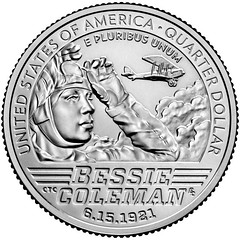 FAA Headquarters in Washington, D.C., was the site of a truly special moment on Tuesday when the U.S. Mint presented a new quarter honoring aviator Bessie Coleman to FAA officials.
FAA Headquarters in Washington, D.C., was the site of a truly special moment on Tuesday when the U.S. Mint presented a new quarter honoring aviator Bessie Coleman to FAA officials.
The coin, presented by Ventris Gibson, former FAA chief human capital officer and now director of the U.S. Mint, occurred in the most fitting of places — The Bessie Coleman Room — and at the most fitting of times, Black History Month.
In presenting the coin, Gibson said Bessie Coleman "defied the odds and … became an aviator. Her tenacious drive and fearless personality helped pave the way for future generations of aviators and for women."
Recalling his own awakening to the world of aviation as a small child, Acting Administrator Billy Nolen noted "there's no telling what will spark a child's imagination and literally make them take flight. As someone who is concerned about aviation's workforce and how we will meet the needs of our country in the future, I am always buoyed and excited by these kinds of stories," because they're the about the key moments that bring people into aviation. Perhaps, he intimated, the new coin will do just that for someone in the future.
The coin is the first issued this year under the Mint's "American Women Quarters Program." Coleman was the first licensed African American and Native American female pilot, and the first African American to earn an international pilot's license.
The reverse (tails) side of the quarter depicts Bessie Coleman as she suits up in preparation for flight. Her expression is reflective of her determination to take to the skies, the only place she experienced a freedom she did not have on the ground. Among the inscriptions is "6.15.1921," the date Coleman received her pilot's license.
To read the complete article, see:
U.S. Mint Presents its New Bessie Coleman Commemorative Quarter to the FAA
(https://www.faa.gov/newsroom/bessie-coleman-quarter)
To read the earlier E-Sylum article, see:
BESSIE COLEMAN QUARTER LAUNCH CEREMONY
(https://www.coinbooks.org/v26/esylum_v26n08a10.html)
VOCABULARY TERM: MINTMASTER
Here's another entry from Dick Johnson's Encyclopedia of Coin and Medal Terminology. -Editor
Mintmaster. A chief official of a mint; the person held responsible for production and quality of coins and medals from a producing location. Originally this title, like that of, say a beer brewmaster, implied a tremendous amount of knowledge and technical skill to satisfactorily produce coins, all this in addition to administrative ability to direct and control a workforce. Later the term fell from active use as mint functions became more specialized, like coiner or chief coiner, assayer, engraver or chief engraver and such.
The administrator of a mint became a superintendent or director of the mint. However so important was this position in the middle ages that the mintmaster was allowed (even required!) to place his signature in the form of a monogram or letter (mintmaster's mark) on every coin struck under his control. This made the mintmaster responsible for the metal content (fineness) and quality of every coin bearing his mark. Punishment for not maintaining either of these often meant the loss of a limb or death (dishonest mintmasters were dealt the same harshness as were counterfeiters).
References:
E3 {1902-30} Forrer. See Mint-Masters 4:88-92 and 8:61-65.
To read the complete entry on the Newman Numismatic Portal, see:
Mintmaster
(https://nnp.wustl.edu/library/dictionarydetail/516325)
ALLEN NYSTROM (1909-2009)
E-Sylum Feature Writer and American Numismatic Biographies author Pete Smith submitted this article on Seattle area numismatist Allen Nystrom. Thanks! -Editor
Allen Nystrom (1909-2009)
Allen Nystrom never rose to prominence in numismatics on a national level. Service at the local level resulted in Allen and his wife, Nina, being named Numismatic News Numismatic Ambassadors in 1979.
I started my research with his obituary published by the funeral home. It gave his name as Allen Richard Nystrom and his life dates as January 17, 1909 – April 30, 2009. This was followed by a summary of his hundred-year life.
Allen R. Nystrom, age 100, passed away in Shoreline, WA. He was born to Leonard and Emma Nystrom in Velma, ND on January 17, 1909 but was a resident of Washington for many years. Allen was known for his cheerful disposition and love of homemade chocolate chip cookies.
I found an interesting wooden nickel offered on eBay. One side told me that he collected Washington trade tokens and wooden money. The other side noted that he specialized in pool and billiard tokens. Thus, I learned more of interest from a wooden nickel than from his obituary.
What else might be learned from a wooden nickel? Another piece in my collection stated, ALLEN & NINA NYSTROM / MARRIED / NOV. 21st, 1933 / EVERETT/ WASH. / 1933-1983.
Still another stated that he collected WWII Ration Tokens and related items.
I have eighteen wood flats issued by the Nystroms from 1973 through 1995 wishing their friends a Merry Christmas. The last three had just the name of Allen after the passing of Nina in 1990.
An obituary in The Seattle Times had some actual useful information. He had worked in construction and was the oldest member of Carpenter's Local 131, being a member for just short of 67 years. The obituary stated he, had strong interest and participation in the Pacific Northwest Numismatic Assoc. The Seattle Northwest Numismatic Society, and IOWMC, DWMC and the Western Wooden Money Society.
He had no surviving children.
If you look for biographical information on the Newman Numismatic Portal, you will find more with his listing of woods than with his listing on American Numismatic Biographies. That is being corrected for the next update.
WHY THE FIRST MINT STAYED IN PHILADELPHIA
Roger Burdette published an insightful article for CoinWeek on why the U.S. Mint never moved from Philadelphia to the new capital city, Washington, D.C. The mint headquarters is there, but Philadelphia remains to this day the home of the nation's largest and most important minting facility. Here's an excerpt - see the complete article online for more information. -Editor
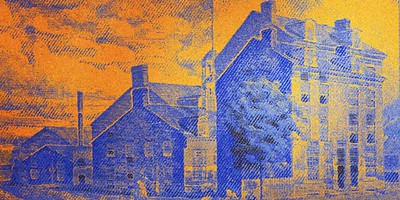 In 1792, when the first U.S. Mint was getting started, the nation's capital was in Philadelphia. Congress met in Congress Hall, and government offices were scattered nearby in rented space. Our new national mint could not operate in rented buildings–the equipment was too heavy and bulky, plus there were horses to accommodate, and the security of precious metals and struck coins was important. The solution was to purchase a site somewhat outside the city center.
In 1792, when the first U.S. Mint was getting started, the nation's capital was in Philadelphia. Congress met in Congress Hall, and government offices were scattered nearby in rented space. Our new national mint could not operate in rented buildings–the equipment was too heavy and bulky, plus there were horses to accommodate, and the security of precious metals and struck coins was important. The solution was to purchase a site somewhat outside the city center.
The history of the first United States Mint has been the subject of several numismatic books and articles, the definitive one being a 2011 book: The Secret History of the First U.S. Mint: How Frank H. Stewart Destroyed – And Then Saved – A National Treasure, by Joel Orosz and Leonard Augsburger. All of these explain the Philadelphia Mint and its problems dealing with poor equipment, insufficient and irregular bullion, and the overall decrepit conditions for man and beast.
With a clumsy hodgepodge of buildings and a site intruded upon by alleys, it is somewhat confusing to try and understand why this was permitted to occur. Certainly, Thomas Jefferson, Alexander Hamilton, and others were aware of how mints in London and Paris were designed. It is difficult to believe that they seriously considered the Philadelphia Mint as a lasting facility for manufacturing the nation's coinage. Taken as a whole, the Mint resembled a country farm or a village blacksmith's shop rather than an important government office. A deeper look suggests that permeance was not part of the Philadelphia Mint's original plan.
[The] location was, at the time, somewhat away from the population center along the Delaware River and was considered semi-rural. The decision to use horse power rather than water power avoided buying expensive property along the Delaware or locating the Mint on distant pasture land along the Schuylkill River. After all, this was a temporary arrangement.
Congress had previously passed the Residence Act of 1790[1], which would move the national capital to a location along the Potomac River – a place to be determined by President George Washington. The law stipulated that in 1800, all government offices would relocate to this new capital city. By late 1800, all branches of government were in the new City of Washington
except one lone bureau: the U.S. Mint Bureau.
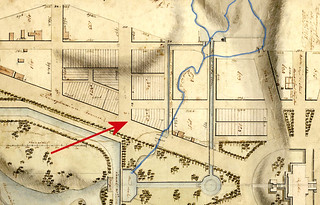 Plans for the new capital included a large lot for the Mint along Pennsylvania Avenue near the Capitol building. The lot had access to a good stream, called Tiber Creek, which would allow the use of water to run equipment instead of horses. It was not far from the Treasury Department building and was close enough to Congress' meetings that sample coins could be taken there for members to examine within a few minutes of being struck.
Plans for the new capital included a large lot for the Mint along Pennsylvania Avenue near the Capitol building. The lot had access to a good stream, called Tiber Creek, which would allow the use of water to run equipment instead of horses. It was not far from the Treasury Department building and was close enough to Congress' meetings that sample coins could be taken there for members to examine within a few minutes of being struck.
As the deadline for moving to Washington City approached, various obstacles arose regarding the relocation of the Mint. The most important of these are mentioned in Director Boudinot's January 1 report to President John Adams. The director made a thinly veiled pitch to the president for keeping the Mint in Philadelphia, despite the need for major repairs and the small scale of the entire operation...
"This will appear in a much longer and detailed chapter in the book Mine to Mint 2 that I am currently writing. (Mine to Mint 2 is a follow-on to From Mine to Mint. The new book supplements and expands the first one and does not merely repeat content. Much of Mine to Mint 2's content comes from suggestions by collectors and hobby professionals. No publication date has been determined."
To read the complete article, see:
Roger Burdette: Why the First Mint Stayed in Philadelphia
(https://coinweek.com/us-coins/roger-burdette-why-the-first-mint-stayed-in-philadelphia/)
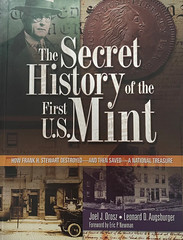 To read earlier E-Sylum articles, see:
To read earlier E-Sylum articles, see:
NEW BOOK: THE SECRET HISTORY OF THE FIRST U.S. MINT
(https://www.coinbooks.org/esylum_v13n49a04.html)
BOOK REVIEW: THE SECRET HISTORY OF THE FIRST U.S. MINT
(https://www.coinbooks.org/esylum_v14n17a07.html)
THE MAKING OF THE SECRET HISTORY OF THE FIRST U.S. MINT
(https://www.coinbooks.org/esylum_v14n11a04.html)
NEW BOOK: FROM MINE TO MINT
(https://www.coinbooks.org/esylum_v16n12a04.html)
BOOK REVIEW: FROM MINE TO MINT
(https://www.coinbooks.org/esylum_v16n17a06.html)
ST. JAMES'S COMPTON DUNDON HOARD AUCTION
The St. James auction coming up on March 1st features a hoard of late Roman coins. Here's the press release. -Editor
St. James's Auctions is pleased to present the Compton Dundon Hoard of Late Roman Coins for auction on 1st March 2023.
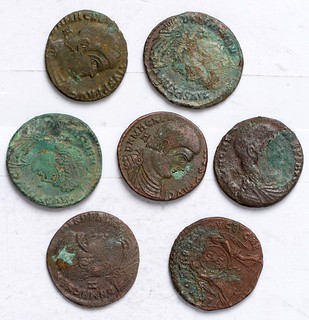 In 2017 an important hoard of Roman coins was found in the village of Compton Dundon in Somerset, the exact location has been kept secret, but the hoard is known as
In 2017 an important hoard of Roman coins was found in the village of Compton Dundon in Somerset, the exact location has been kept secret, but the hoard is known as The Compton Dundon Hoard
. The hoard consisted of 564 base metal coins of the denomination Nummus
, previously termed Centenionalis
. Importantly a large part of the hoard consisted of coins of the usurper Emperor Magnentius and his brother Decentius (AD 350-53). The hoard was recorded as GLO-574C93 and declared as treasure and a selection was acquired by the Museum of Somerset after being recorded and partially cleaned by the British Museum. The Christogram coins of the usurper Emperors are one of the most demonstrative of the Christian faith within Roman coinage.
The hoard is offered for sale in its Museum cleaned condition
ready to be finally conserved and improved. CD references are those used by the British Museum in the identification listing.
The hoard will feature in St. James's Auctions, Auction 72, to be held 1st March 2023, lots 1 to 34. The auction will begin at 11am. Bidding will be available by commission bid or via online bidding.
For your information you can see the auction here
https://bsjauctions.auctionmobility.com/auctions/1-723AA1/st-jamess-auctions-auction-72 and the catalogue here
https://cdn.sanity.io/files/f3pcy24e/production/ce8ee0a07c09f31bc9bb459655
258b6b2cb9b7ae.pdf
DAVISSONS AUCTION 42 ANGLO-SAXON
In an email to customers last week, Allan Davisson previewed Anglo-Saxon coins in the upcoming March 1st 2023 Davissons Ltd. Auction 42. -Editor
Some things come around just once in a generation. Or even more rarely.
Pat Zabel's Collection of Anglo-Saxon Coins of the British Isles is one such shiny thing — an opportunity here for just a few more days. Then, on March 1, gone over the course of a few hours.
The vast array of rare Anglo-Saxon sceats and pennies that Pat found over many years of searching is the centerpiece of our auction this time, and a significant event in British numismatics. The quality and variety is breathtaking.
Eighth through eleventh century England was a tumultuous time when Christianity and paganism fought for the heads and hearts of the British people. (The Netflix series The Last Kingdom,
based on the series of books by Richard Cornwell, brought it to life for us while biking inside on our winter stands last year.)
The thirty-one sceats that open the Anglo-Saxon section along with the three gold thrymsas at the beginning of the sale form an unusually large and significant representation of this early form of currency. Metcalf (Thrymsas and Sceattas in the Ashmoleon Museum Oxford) notes that There are about a hundred distinct varieties of English sceattas, minted during a period of a little less than a hundred years.
This collection offers a significant percentage of the series. And Pat Zabel's focus on quality makes the assemblage even more remarkable. (The later sceatta coinage and continental Anglo-Saxon issues will be featured in our Spring E-Auction 46.)
Moving on to the pennies—The finely trimmed round, thin-flan denier type coinage that emerged after the influence of Charlemagne offers a rich panoply of style and design that ranks high in the history of numismatic artistry. The collection includes portrait pennies of Cuthred, Beornwulf, Burgred, Aethelbert, Aethelred I, Alfred the Great, Edward the Martyr, Harold I, Harthacnut, Edward the Confessor, and Harold II.
The searing ambivalence of the St. Peter's Coinage penny (lot 281)–the struggle to reconcile Christianity with the Nordic pagan invasion into Britain–is eloquently captured here with the sword of St. Peter on one side and the hammer of Thor on the other. (I handled this in the 1990's and was happy to have it come around again, something I can happily report about a substantial number of these pieces.)
The flowery grace of the design on the coin of Offa (lot 274) whose reign boasted a broad range of designs.
The portraiture of various reigns, including the superb Edward the Martyr (lot 292)—distinctive for each, even though there was no apparent effort at realism. (Contrast this rich variety with the repetitious portraiture of the Plantagenets that prevailed until the Tudors finally changed things.)
The scarcity of so many of these coins made estimating particularly challenging. I strive to estimate at a level that I believe fairly reflects a reasonable level in today's market. To take a prime example, prices on the marvelously pedigreed Beornwulf penny (lot 276) are available for ten pieces sold since 2007. Prices for the 6 intact pieces (the other four sold were fragments) ranged from about $3500 for a piece that had been lightly tooled and gilded to a piece at Spink with a pedigree back to 1807 that sold for nearly $30,000 in 2018. The 2023 Spink catalog value on the piece in VF is £6000. The approach fairest to both seller and buyer, I decided, was to estimate at a level that is not off-putting to a potential bidder but also a fair return to Pat's estate. With such a small sample, some kind of median price makes more sense than using an extreme—a possible outlier value. (I sold the piece to him in November of 2000 for $4500.)
I could discuss many of the rest of these rarities in similar detail. I am impressed again by the quality of the material and I am also impressed that values have gone up dramatically for choice coins from the Anglo-Saxon era.
What great fun you must have had putting this together!
was the e-mail message I got from one long-time and prominent collector of British hammered coins.
He was spot on. For me, it has been a terrific opportunity and great pleasure.
And now, after nearly a quarter century together, it is humbling to contemplate that in less than two weeks' time a new generation of stewards will take possession of these remarkable artifacts of their long-ago age, and they will be spread to the four winds.
To browse the online and print catalogs, see:
https://davcoin.com/sale/Printed%20Auction%2042
https://davcoin.com/pdf-viewer/43873
To read the earlier E-Sylum articles, see:
DAVISSONS AUCTION 42 ANNOUNCED
(https://www.coinbooks.org/v26/esylum_v26n05a21.html)
DAVISSONS AUCTION 42 PREVIEW
(https://www.coinbooks.org/v26/esylum_v26n07a20.html)
DAVISSONS AUCTION 42 ANCIENTS
(https://www.coinbooks.org/v26/esylum_v26n08a23.html)
SYDNEY F. MARTIN COLLECTION PART THREE
A Stack's Bowers blog article by John Kraljevich announces part three of the Syd Martin collection. Syd was a great guy - a member of the Numismatic Bibliomania Society board, and most importantly, a significant researcher, author and collector of U.S. Colonial coinage. -Editor
THE MIDDLE COLONIES SALE
1788 Connecticut Coppers • New York & Related Coinages • Immune Columbia, Confederatio & Related Issues Maryland Coinages • Virginia & Related Coinages • Elephant Tokens, American Plantations Tokens, & c.
Welcome to the third chapter of our offering of the Syd Martin Collection. We've gathered together a seemingly disparate group of early American numismatic items and titled this The Middle Colonies Sale.
The offerings, historically and economically, may be more connected than they would seem at first blush.
New York City has been the economic and cultural powerhouse of the Northeast for centuries (though the Philadelphia area, environs both Syd and I have called home, is clearly superior when it comes to professional sports). From the orbit of New York we have gathered numismatic items from three different centuries. The Dutch Lion dollars (and the half fraction) cover the first two centuries, a harkening to New York's Dutch heritage that remained apparent in colonial pockets well into the 18th century. The important 1709 4 Lyon Dollars note serves as a bridge from that heritage to colonial New York, as does the enigmatic late 17th century New Yorke in America token, an English-language piece that was probably struck in the Low Countries.
As New York boomed after the departure of the English at the end of the American Revolution, its importance as a financial center took hold. The regulated gold coins Syd collected, led by a very important Portuguese half Joe regulated by Ephraim Brasher, show how central New York was to the import/export trade that brought immense wealth to the city. At the end of the 1780s, New York passed on making its own coins — though the patterns and related issues are all included here — but there was plenty of coin-making going on nearby. Up the Hudson, Capt. Thomas Machin was making counterfeits in Newburgh. And in nearby New Haven (and Machin's Mills too!), 1788-dated Connecticuts would give Syd a series to pour his passion and expertise into. This is one of the finest and most complete offerings of 1788 Connecticut coppers ever auctioned, paired with some of the finest cataloging ever done on the series by our house expert Kevin Vinton.
From upstate New York come two issues that couldn't be more different, though Syd found them each appealing in their own way. The Albany Church Pennies are simple: two varieties, overstruck on low weight halfpence, produced by the First Presbyterian Church in Albany after the Copper Panic of 1789. Syd got both varieties, and to increase the challenge, added contemporary communion tokens from two other Presbyterian churches, one in New York and the other in Charleston. The Castorland medals are very complex. Inspired by a colonization effort during the French Revolution, the die states tell the whole story of this coinage over the course of decades. Syd delved right in.
Other tokens from the New York area are also included, including a very impressive run of Talbot, Allum, and Lee cents by variety, several varieties of Mott tokens, and the ca. 1785 Bar copper, which was introduced to the New York area just after Revolution.
In the Chesapeake region, Maryland and Virginia were more alike than not economically. Tobacco made both colonies viable (unpaid enslaved labor to harvest that tobacco helped), and through the 18th century they saw similar coins, similar markets, and similar economic interests evolve. Virginia's tobacco economy started in Jamestown, the short-lived settlement that served as the colony's capital from the time of its founding in 1607. Just two years later, a group of colonists on their way to Jamestown from England were blown off course in a storm and landed on what became a new English colony: Bermuda. The 1616 Hogge Money issues were struck just a year after the Virginia Company ceded control of Bermuda to the newly founded Bermuda Company, and the two colonies continued a deep interrelation for most of the 17th century. The Sommer Islands pieces included here are American colonial classics, and Syd found important specimens to include in his cabinet.
In Maryland, Lord Baltimore's coinage took hold in 1659 and the years that followed, and Syd's collection is one of the best anyone has ever assembled. More than a century later, after St. Mary's City yielded to Annapolis as the state capital, the Federal government took its seat in Annapolis's State House for a time — the same time that silversmith John Chalmers got busy striking silver coins for local circulation. Syd's Chalmers collection is led by the legendary Rings Shilling, one of the most important types in the entire canon of American numismatics.
The peculiarities of Virginia halfpence lent themselves well to Syd's brand of expertise. Few people attribute them when they sell; Syd was happy to. Few people collect them by variety; Syd did, gathering 27 varieties and the very rare shilling. Among paper money issues, he also acquired the finest known 1775 pistareen note, an important type that recognized the vital role that Spanish mainland 2 reales (and their cut fractions) played in the Chesapeake economy.
Looking west to Kentucky, the Myddelton tokens have a lot in common with the Castorland medals: a colonization scheme that went nowhere, a foreign mint, and beautiful medal-like coins by legendary artists that have been avidly sought for centuries. Syd built out his Myddelton tokens with related mulings from the Copper Company of Upper Canada, as many collectors did before him.
The Carolinas can claim no native coinage, despite their ancient and interesting history in colonial times. But the Carolina Elephant tokens stand in nicely. Syd augmented his Carolina Elephants with nearly every possible permutation of the related London Elephant tokens, often in superb grade, and managed to acquire one of just three known New England Elephants, only two of which are in private hands.
The American Plantation tokens refer to the South in a general sense, but no one knows where they were actually intended to circulate. In 1688, when they were struck, the Carolinas extended to the border of Spanish settlements in Florida, and the unusual fractional Spanish denomination (1/24 real) makes clear they meant for somewhere close to the Spanish dominions. Syd assembled an advanced collection including all the notable varieties.
This sale is a real smorgasbord, covering a vast time period, a widespread geographical area, from advanced trophy rarities to hard-to-find obscurata. Syd didn't shy away from challenges, and this sale is reflective of that ardor. It's ended up being one of the finest arrays of early American coins ever sold in a single auction.
Enjoy the coins and the history. Syd did a lot of work to bring these coins together, knowing that ultimately they'd be appreciated by someone else someday.
To read the complete article, see:
THE SYDNEY F. MARTIN COLLECTION PART III FEATURED IN SPRING 2023 EXPO AUCTION MONDAY, MARCH 20, 2023 • 10:00 AM PT
(https://stacksbowers.com/the-sydney-f-martin-collection-part-iii-featured-in-spring-2023-expo-auction-monday-march-20-2023-1000-am-pt/)
SYD MARTIN TALBOT, ALLUM & LEE CENTS
Another Stack's Bowers blog article by Chris Bulfinch discusses the overstriking of U.S. Half Cents on Talbot, Alum & Lee cents - several examples are included in the Syd Martin collection. -Editor
In the 1790s the fledgling United States Mint was casting about for the metal it desperately needed. One source of copper was Talbot, Alum & Lee, a New York-based East India trading company partnership established in 1794 that contracted with Peter Kempson's mint in Birmingham, England to produce thousands of copper one cent tokens, roughly the size and weight of a British halfpenny. These tokens were used to strike cents and half cents from 1795 to 1797. The Sydney F. Martin Collection included many of these issues, which will be offered for sale in Part III of our sale of this legendary collection, which will take place March 20, 2023, the first session our Official Auction of the Whitman Coin & Collectibles Spring Expo.
Liberty appears on the tokens' obverse in front of a large parcel holding a staff topped by a liberty cap with the words LIBERTY AND COMMERCE
arcing above her and the date below. The reverse depicts a merchant ship surrounded by the firm's name, NEW YORK,
and the denomination. Edge lettering reads PAYABLE AT THE STORE OF.
In 1795, the firm sold more than 50,000 of the tokens to the United States Mint for use in coining copper cents and half cents, though the latter was the only issue for which using the tokens as planchets (after cutting down) made sense. Some 1795 cents were struck using the tokens, as were half cents. In December 1796, the Mint bought the remaining stock of cent tokens, which amounted to nearly a ton. Included in our Syd Martin Part III auction is one such overstruck 1797 half cent found in lot 1152.
The undertype is discernible on some of the coins struck using Talbot, Allum, & Lee tokens.
Produced in quantities larger than most other U.S. merchant tokens at the time, Talbot, Allum & Lee cents are considered Conder tokens and a number of the dies bearing the designs intended for the firm are paired with dies used for other, unrelated Conder tokens. Edge lettering and other subvarieties are also known, some of which are extremely rare or unique. Three varieties are listed in the Red Book's Post-Colonial Issues section, but the series is far more extensive. It encompasses common varieties that can be collected at relatively low cost, as well as pieces that are quite rare and valuable.
We're fortunate to offer a number of exceptional Talbot, Allum & Lee cents in our upcoming offering from the Syd Martin Collection. Among the pieces offered is a 1794 Fuld-1, W-8560 cent without New York
above the ship on the reverse, the rarest of the Red Book varieties and a unique 1795 subvariety bearing edge letter reading CAMBRIDGE BEDFORD HUNTINGTON.
Other mules and high-grade examples are featured, as well as errors, which are rare for the type.
To read the complete article, see:
DID YOU KNOW TALBOT, ALLUM & LEE CENTS WERE CUT DOWN AND USED AS HALF CENT PLANCHETS IN THE 1790S?
(https://stacksbowers.com/did-you-know-talbot-allum-lee-cents-were-cut-down-and-used-as-half-cent-planchets-in-the-1790s/)
KUENKER SPRING 2023 AUCTION SALES 385-386
Here's the second part of a press release for Künker's Spring Auctions, covering sales 385-386. -Editor
Catalog 385: Absolutism, Enlightenment and the French Revolution as Reflected by Coins and Medals – The Bader Collection
Every collector creates their own universe based on coins, medals, orders, decorations and other items. Nothing but their interpretation determines why these objects belong together. The Bader Collection, for example, deals with the question of how the absolutism of the early modern period developed into Napoleon's military dictatorship. With his collection, Frank Bader illustrates how various monarchs depicted their appreciation for the Enlightenment on coins. In this way, he pursued an interesting and demanding question, which led to a second collection: awards and insignia of the French Revolution.
What can we expect from the Bader Collection? Well, for one, there is a rich offer of German coins, mainly from Prussia with a focal point on the philosophical king Frederick II. But you can also discover a great selection of Habsburg coins, especially by Frederick's rival, Maria Theresa; of course, her Enlightened son Joseph II is also represented. There is also a large run of European coins and medals, for example a selection of Russian pieces and, of course, more than 150 lots of French coins and medals from Louis XV to Napoleon.
The second part of the auction, which is described by the order specialist Michael Autengruber, is almost even more touching. It contains the awards and insignia of the French Revolution, and it really gets to one when we see a lead medal featuring the guillotine that was set up and used in Lyon in 1793.
For anyone interested in history, this catalog certainly offers a wealth of numismatic food for thought.
No. 3599: Brandenburg-Prussia. Frederick William II, 1786-1797. Albertustaler (Bancotaler) 1797, Berlin. Trade coin. Only 1,050 specimens minted. Extremely fine. Estimate: 3,500 euros
No. 3676: Habsburg hereditary lands. Maria Theresa, 1740-1780. 10 souverains d'or 1751, Antwerp. Very rare. Tiny traces of reworking in the field on the reverse. Very fine to extremely fine. Estimate: 25,000 euros
No. 3854: Russia. Elizabeth, 1741-1761. 10 roubles 1756, Moscow, Red Mint. Very rare. About extremely fine. Estimate: 10,000 euros
No. 3903: France. Louis XV, 1715-1774. Gold medal 1729 by J. Duvivier celebrating the birth of the Dauphin on 4 September 1729. Rare. Extremely fine to FDC. Estimate: 10,000 euros
No. 3986: France. Commemorative medal for the Federative Oath on the Champ de Mars on 14 July 1790 II. Estimate: 500 euros
No. 4097: France. Medal commemorating the guillotine of Lyon (1793). Probably lead cast. II. Estimate: 75 euros
Catalog 386: Coins and Medals from Medieval and Modern Times with Numerous Special Collections
With auction 386, several important special collections enter the market. The sale starts with the first part of the Peter Fleige Collection of bracteates. The 150 most beautiful pieces can be found in auction 386; a second part will follow online as eLive Auction 77 in April 2023. Geographically speaking, the collection ranges from the north of Germany with Bremen, Hamburg and Lübeck down to Lake Constance.
Two collections perfectly complement each other and present an impressive selection of coins from Mainz: almost 250 lots are offered by the collections of Prof. Dr. Alois M. Memmesheimer and Heinz Beaury. Here, too, collectors can find everything pertaining to the subject of Mainz – from simple pfennigs to multiple gold coins. If you are interested in Mainz issues, make sure to save the date on 22 March 2023. You must not miss out on this sale!
Collectors of Brunswick-Lüneburg can also look forward to an extensive special collection with more than 230 lots. The offer ranges from impressive Renaissance talers to rare lösers, high-quality representative talers (including pieces featuring magnificent mining scenes), to the vereinstalers that were minted shortly before the empire was founded in Hanover.
Two further special collections were not included as separate chapters, but their items were incorporated into the section of German and European coinage. One of them is the Cygnus in Nummis
collection, which deals with all the ways in which the depiction of a swan can be interpreted. Moreover, Siegfried Schuckmann sells his collection on Napoleon and his time.
Therefore, there is a lot to discover – not only regarding German issues. Among more than 50 lots with coins from the United States, there is a small collection of Morgan Dollars. The undisputed highlight of Künker's Spring Auction Sales is a rare gold medal by Bloody Mary, the Queen who tried to turn back time in England by reintroducing the Catholic faith. The gold medal was created for her wedding with King Philip II of Spain, and it is actually plausible that the piece offered at Künker was indeed in possession of the English Queen. The outstanding artistic value of this medal has often been highlighted. It is not without reason that this particular specimen was exhibited as part of the landmark exhibition Renaissance Faces
at the National Gallery in London in 2008/2009.
Let us round off our auction preview with the last collection on sale in the Spring Auction Sales: the Coenen Collection of patterns for German coins minted after 1871. It perfectly complements the small but exquisite offer of coins from this era.
Last but not least, it should be mentioned that auction 386 offers the entire library of Prof. Dr. Niklot Klüssendorf as a single lot. The archivist and historian assembled his extensive specialist library over about 50 years. It contains 2,000 works and has a starting price of 10,000 euros.
To order a catalog contact Künker, Nobbenburger Straße 4a, 49076 Osnabrück; phone: +49 541 / 962020; fax: +49 541 / 9620222; or via e-mail: service@kuenker.de. You can access the auction catalogs online at www.kuenker.de. If you want to submit your bid from your computer at home, please remember to register for this service in good time.
No. 4752: Alois Memmesheimer Collection / Mainz. Anselm Franz von Ingelheim, 1679-1695. 2 ducats 1680, Mainz. Very rare. Extremely fine. Estimate: 15,000 euros
No. 4876: Heinz Beaury Collection / Mainz. Karl Heinrich, Count of Metternich-Winneburg 1679. Gulden (60 kreuzers) 1679. From the Dr. Rudolph Walther Collection, Peus auction 275 (1971), No. 386. Very rare, probably one of three known specimens in private possession. Extremely fine. Estimate: 7,500 euros
No. 4972: Cygnus in Nummis Collection. Bentheim. Moritz, 1623-1674. Triple reichstaler 1657, Rheda. The only known specimen. Very fine. Estimate: 40,000 euros
No. 5064: Collection Brunswick and Lüneburg. Brunswick-Wolfenbüttel. Ferdinand II, 1735. Reichstaler 1735, commemorating his death on 13 September. From Peus auction 270 (1969), No. 574. Extremely rare. About FDC. Estimate: 12,500 euros
No. 5470: Siegfried Schuckmann Collection / Napoleon and His Time. Kingdom of Westphalia. Hieronymus Napoleon, 1807-1813. 1 franc 1808. Extremely rare. About FDC. Estimate: 2,500 euros
No. 5766: Morgan Dollars Collection. USA. Silver dollar 1893 CC, Carson City. PCGS MS62. Extremely fine +. Estimate: 750 euros
The mintmark is a cataloging mistake, and the auction house has made corrections. -Editor
No. 5819: Great Britain. Mary, 1553-1558. Gold medal n.d. (around 1554), by J. da Trezzo. Original cast. Extremely rare. Extremely fine. Estimate: 600,000 euros
No. 5856: Russia. Elizabeth, 1741-1761. Broad gold medal by J. Dassier, commemorating the foundation of the Moscow State University in 1754, minted in 1758. From Schlessinger auction (1934), No. 436. Extremely rare. Extremely fine. Estimate: 50,000 euros
GADOURY MARCH 2023 AUCTION
This press release describes highlights from the upcoming Gadoury sale, featuring gold from Portugal, France and Italy. -Editor
Gold from Portugal, France and Italy
On 25 March 2023, Gadoury will auction off the collection of Monsieur B. de Z. It contains a rich selection of rare Portuguese medals, as well as French and Genoese gold coins including numerous rare pieces. The highlight is another part of the royal collection Casa Savoia with great rarities.
If you collect pieces from Portugal, France, Genoa, Casa Savoia or USA, be sure to save the date: on Saturday, 25 March 2023, Éditions Victor Gadoury in Monaco will offer important special collections on all five topics. Francesco and Federico Pastrone invite you to the elegant Hôtel Méridien Beach Plaza. A splendid opportunity to combine your passion for numismatics with a short break from the daily business.
Portuguese Medals
Portugal's history was crucial for the development of Europe. Not only because the great explorers opened up new markets for European goods and because Portuguese ships provided the markets of the Old World with gold from Africa and Brazil – the great Lisbon Earthquake of 1755 also inspired the thinkers of the Enlightenment.
Portuguese medals commemorate this great history. Gadoury is able to offer gold, silver and bronze pieces, including numerous great rarities.
Lot 8: Portugal. João V, 1706-1750. Gold medal for the anniversary of the foundation of the Royal Academy in 1720. Extremely rare. Minor damage in the field, otherwise very fine to extremely fine. Estimate: 20,000 euros. Diameter: 50mm
Let us begin with an extremely rare gold medal by João V, the Portuguese king under whose rule Brazilian gold made it possible to build the impressive Palace of Mafra. On 22 October 1721, the first anniversary of the Royal Academy, this medal was awarded to its most distinguished members. The King himself attended the ceremony and received gold specimen of the medal. An index of the Casa de Moeda tells us that only 12 gold specimens and 120 silver specimens were minted for the occasion. The official speaker, the Marquês de Abrantes, pointed out in his eulogy that the coin design was inspired by a sesterce of the Roman Emperor Vespasian.
Lot 13: Portugal. José I, 1750-1777. Gold medal commemorating the erection of the statue of José I at Praça do Comércio in 1775. Extremely rare. Minor damage in the field, otherwise extremely fine. Estimate: 10,000 euros. Diameter: 46mm
Another example is the extremely rare medal that was issued to celebrate the erection of a monument for José I. During his reign, the terrible Lisbon Earthquake took place. Under the leadership of the Marquês de Pombal, the people affected by the earthquake were given fast and effective help and the country took on the task of rebuilding Lisbon. Part of this construction project was the Praça do Comércio, where the customs and harbour administration was established. To this day, the statue for whose erection this medal was issued can be admired in the centre of the square.
Lot 16: Portugal. Maria I, 1777-1816. Gold medal for the laying of the foundation stone of the church of the Convent of the Most Sacred Heart of Jesus. Rare. Minor damage in the field, otherwise extremely fine. Estimate: 15,000 euros. Diameter: 53mm
The last medal in this group that we would like to present recalls Queen Maria I, the first woman on the Portuguese royal throne. The fact that she was the ruler of Portugal is shown on the medal's obverse, which clearly puts Maria in the foreground. She and her husband Peter III had to wait a long time until they got children. Therefore, Maria vowed to build a church for the Convent of the Most Sacred Heart of Jesus. In fact, following this a first son was born in 1761; another two sons and three daughters followed. Maria had to wait for her accession to the throne in 1777 until she could actually plan a new church. In 1779, the foundation stone was laid. The medal was created to celebrate this occasion. When the church was completed in 1790, the son who had prompted its construction had already died of smallpox. After his mother's death, his younger brother João VI took over the rule in 1816.
Lot 114: France. 20 francs, Turin 1813 U. Only 925 specimens minted. NGC XF40. Estimate: 7,000 euros. Diameter: 21mm
Lot 115: France. 20 francs, Genoa 1814 CL. Only 887 specimens minted. NGC XF40. Estimate: 7,000 euros. Diameter: 21mm
French Gold Coins from Napoleon I to the Third Republic Do you collect French gold coins by year and mint? In that case, the Gadoury auction house has an extensive offer for you, including many great rarities: among the exactly 100 lots of modern French gold coins are extremely rare years and mints such as Turin (year 14 U), Perpignan (1818 Q), Turin (1818 U), La Rochelle (1809 H), Bordeaux (1813 K), Turin (1813 U), Genoa (1814 CL) for 20-franc pieces and Turin (year 14 U) and Limoges (1807 I) for 40-franc pieces.
Gold Coins from Genoa
In the Middle Ages and the beginnings of the early modern period, the Serenissima Repubblica di Genova was at least as powerful economically – if not more powerful – than its rivals Florence and Venice. Part of this power were Genoese gold coins, which circulated in the markets of the world. Those interested in Genoese coinage will have the unique opportunity to choose from a rich offer of partly extremely rare pieces at the upcoming Gadoury auction sale. The time frame of the 171 lots ranges from the High Middle Ages with the first genovini d'oro to Napoleon's gold coins, minted in Genoa in 1813.
Lot 202: Genoa. Barnaba di Goano, 1415. Genovino d'oro. Extremely rare. NGC AU53. Estimate: 20,000 euros. Diameter: 20mm
As a first rarity, let us mention an extremely rare genovino d'oro by Barnaba di Goano, who helped put an end to the civil war of 1414 and 1415. He was elected doge in 1415 but lost his office as early as three months later. Some bad decisions had enabled intriguers to replace him. His short reign is the reason why this coin is so extremely rare. It is all the more impressive that NGC graded this rarity MS62.
Lot 211: Genoa. Ludovico di Campofregoso, 1461-1463. Genovino d'oro. Extremely rare. PCGS MS63. Estimate: 10,000 euros. Diameter: 21mmAbout half a century later, a genovino by Ludovico di Campofregoso was created. He held the office of doge for about 47 months, spread over three terms. Ludovico was a Fregoso, i.e. he was from the large family that provided the highest number of doges in the history of Genoa. A great commander himself, he became doge for the first time in December 1447 and stepped down in September 1450. In late July 1461, Ludovico became doge for the second time. But his cousin Paolo, who also held the office of Archbishop of Genoa, deposed him. Less than three weeks later, Ludovico was doge again, but Paolo succeeded a second time – and this time for good – in taking the reins from him. However, Paolo's tenure was not a successful one either. The Council of Elders deposed him and placed Genoa under the rule of Milan. The fiorino offered at Gadoury recalls this exciting period, is very rare and of outstanding quality. PCGS graded it MS63.
Lot 227: Genoa. Francis I, King of France and Lord of Genoa. Ecu au soleil, 1527-1528. Extremely rare. NGC AU58. Estimate: 20,000 euros. Diameter: 26mmFor all those interested in European history, this écu au soleil is a central piece. King Francis I of France had it minted in Genoa from 1527-1528. Francis, who disputed Charles V's rule in Italy, was taken prisoner in 1525 in the Battle of Pavia. He was released in 1526 but had to sign a peace agreement that, among other things, stipulated that Spain was the ruler of Genoa. However, as soon as Francis I was free, he revoked all the concessions. The Genoese issue bearing his name is nothing but a declaration of war against Charles V.
Lot 282: Genoa. 5 doppie, 1640. Very rare. NGC MS63. Estimate: 30,000 euros. Diameter: 42mmLot 284: Genoa. 5 doppie, 1692. Very rare. NGC AU58+. Estimate: 25,000 euros. Diameter: 42mm
Gadoury is in a position to offer an entire series of impressive 5-doppie pieces, which feature Virgin Mary with Child Jesus on the obverse. All of them are remarkable, but one stands out. The 1640 5-doppie piece was graded MS63 by NGC.
Lot 359: Italy / Casa Savoia. Carlo Emanuele III. Carlino da 5 doppie, Turin 1757. NGC AU55. Extremely fine. Estimate: 30,000 euros. Diameter: 41mm
Lot 549: Italy / Casa Savoia. Vittorio Emanuele II. 50 lire, Turin 1864. Only 103 specimens minted. Minor adjustment marks and tiny scratches, otherwise extremely fine. Estimate: 120,000 euros. Diameter: 27,5mm
Lot 615: Italy / Casa Savoia. Vittorio Emanuele III. 100 lire PROVA (pattern), Rome 1925. Extremely rare. NGC PF62 MATTE. Estimate: 40,000 euros. Diameter: 35mm
Lot 616: Italy / Casa Savoia. Vittorio Emanuele III. 100 lire aratrice, Rome 1927. Only 30 specimens minted. NGC MS60. Estimate: 80,000 euros. Diameter: 35mm
Gold Coins of Casa Savoia
Once again, we present pieces from the royal collection of Casa Savoia coinage. As was the case with the other parts of this extensive collection, connoisseurs will find numerous extremely rare gold pieces in excellent condition. The high quality of the offer is demonstrated by the fact that among the 296 lots are 33 pieces with five-digit estimates, one is even estimated at 120,000 euros. It is an extremely rare 50-lira piece, of which 103 specimens were minted in Turin in 1864. Lot No. 616 is even rarer. Only 30 specimens were minted in Rome in 1927 of this 100-lira piece by Vittorio Emmanuele III. Its condition is remarkable too: NGC graded it MS60. Of even better quality is the extremely rare 1925 pattern offered as lot No. 615, it was graded PF62 MATTE by NGC.
However, these rarities should not conceal one thing: collectors with a normal
budget will also find a wealth of pieces at this Gadoury auction sale. There are many pieces with estimates in the lower three-digit range, starting at 100 euros. Thus, it is worthwhile for every collector to take a close look.
Lot 653: USA. 20 dollars, Carson City 1872 CC. NGC AU58. Estimate: 10,000 euros. Diameter: 34mm
Lot 665: USA 10 dollars, Philadelphia 1839 overstruck on 1838. PCGS AU58. Estimate: 10,000 euros. Diameter: 27mm
Lot 726: USA. 10 dollars, New Orleans 1883 O. Only 40 to 50 specimens minted. PCGS XF45. Estimate: 30,000 euros. Diameter: 27mm
Lot 746: USA. 10 dollars, Carson City 1892 CC. Rare. PCGS MS62. Estimate: 10,000 euros. Diameter: 27mm USA
Once again, Gadoury is able to present a rich selection of US gold coins, including numerous rare years and mints. At this point we limit our list to:
- 20 dollars, Carson City (1872). NGC AU58
- 10 dollars, Philadelphia, 1839 overstruck on 1838. PCGS AU58
- 10 dollars, New Orleans (1883). PCGS XF45. Only 40-50 specimens are known of
- 10 dollars, Carson City (1892). PCGS MS62
Lot 799: Romans. Augustus. Aureus, Lugdunum 13-14 BC. Rare. Minor damage, otherwise extremely fine. Estimate: 10,000 euros. Diameter: 20mm
Lot 817: Poland. John II Casimir. 3 ducats 1650. Very rare. Minor traces of cleaning, otherwise very fine to extremely fine. Estimate: 5,000 euros. Diameter: 34mm
World Coins
The auction is rounded off by 30 lots with world coins. The offer ranges from antiquity to the present, from an aureus by Emperor Augustus to contemporary commemorative coins from China and Russia, including six gold coins from Poland. Along with several Polish ducats, the most remarkable among them is the 1650 triple ducat from Danzig minted under John II Casimir, featuring a magnificent city view.
You can order the catalogue at Éditions Victor Gadoury, 57, rue Grimaldi, 98000 Monaco; phone: +377 93 25 12 96; fax: +377 93 50 13 39; email: contact@gadoury.com. You can find the catalogue online at auction.gadoury.com, www.sixbid.com and www.numisbids.com. Of course, it is also possible to bid live on your computer at home via www.biddr.ch!
THE BOOK BAZARRE
NUMISMATIC NUGGETS: FEBRUARY 26, 2023
Here's a selection of interesting or unusual items I came across in the marketplace this week. Tell us what you think of some of these. -Editor
Perseus Tetradrachm
MACEDONIA. Perseus. Under Zoilos. 179-168 BC. Pella or Amphipolis. AR Tetradrachm, 17.03g (35mm, 12h). Laureate head right with stubble beard / Eagle with wings back standing on a thunderbolt; ??S???OS ????SOS above and at eagle's legs. Monogram E to r.; wreath surrounding. Pedigree: Ex Sotheby & Co., London, Auction 22. April 1970, Lot 98 (Fritz Collection)
From the online offerings of Shanna Schmidt. -Editor
To read the complete lot description, see:
Macedonia. Perseus. Under Zoilos. 179-168 BC.
(https://www.shannaschmidt.com/greek-coins/macedonia-perseus-under-zoilos-179-168-bc)
1813 Half Eagle
The 1813 is the closest thing there is to being a common
date in the Capped Head Right half eagle type of 1813-1829. It is seen with some regularity in grades through MS63, but it is scarce in properly graded MS64. It is quite rare in MS64+ and Gems are extremely rare with likely not more than three or four known.
Great coin from the online stock of Doug Winter. -Editor
To read the complete lot description, see:
https://raregoldcoins.com/
Vercelli Synagogue Medal
Medal commemorating the inauguration of a new synagogue in Vercelli (Italy), September 1878. Cast bronze.
Obverse: Relief of the synagogue's facade and an inscription: "I. Muggia. Vercelli". Reverse: inscription -"Inaugurazione del nuovo tempio israelitico in Vercell Settembre 1878" [inauguration of the new synagogue in Vercelli…]. Diameter: 46 mm.
First medal in a lot of two in the Kedem Auction House sale 36 closing today. I don't care for the plain reverse, but the obverse is nice. -Editor
To read the complete lot description, see:
Two Medals – Inauguration of Vercelli Synagogue / Albert Cohn – Italy
(https://www.kedem-auctions.com/en/content/two-medals-%E2%80%93-inauguration-vercelli-synagogue-albert-cohn-%E2%80%93-italy)
Albert Cohn Medal
Medal in honor of Albert (Avraham) Cohn, consultuat to James (Ya'akov) Meir Rothschild for charity matters, 1855. Cast bronze.
Obverse: relief of Tablets of the Law, Menorah and various vessels surrounded by an inscription in Hebrew. Reverse: dedication in Italian "for Alberto Cohn for charity actions for Jews" on behalf of Italian Jews. Diameter: 53 mm.
A second medal in the same Kedem Auctions lot. I don't care for this reverse either, but it's a great obverse. -Editor
To read the complete lot description, see:
Two Medals – Inauguration of Vercelli Synagogue / Albert Cohn – Italy
(https://www.kedem-auctions.com/en/content/two-medals-%E2%80%93-inauguration-vercelli-synagogue-albert-cohn-%E2%80%93-italy)
1909 Tiffany Porfirio Díaz Silver Medal
Tiffany & Co 1909 Commemorative Sterling Silver Token, "Al Heroe De La Paz, El Estado De Chihuahua". Signed Tiffany & Co. Stamped Sterling Silver. Measures 2-3/4" diam. Approx. weight: 5.06 troy ounces Estimate: $300.00 - $500.00 Domestic Shipping: $40.00 Condition: Very good condition.
The legend translates to "To the Hero of Peace, the State of Chihuahua." The medal commemorates the visit of President Porfirio Díaz to the State of Chihuahua. -Editor
To read the complete lot description, see:
1909 Tiffany & Co Silver Commemorative Token
(https://www.bidsquare.com/online-auctions/kodner/1909-tiffany-co-silver-commemorative-token-4786483)
c1925 YMCA Gold Plated Award Medal
Early YMCA gold plated award medal circa 1925 est. value $125.00-$150.00
I'm sure there must have been many medals like this made over the years for various local YMCA's, but I don't believe anyone has ever cataloged them. Nice piece. Anyone know who made it? The listing only pictures on side. -Editor
To read the complete lot description, see:
Lot 5454: Early YMCA gold plated award medal
(https://www.invaluable.com/auction-lot/Early-YMCA-gold-plated-award-medal-5454-c-9E5498491B)
WAYNE'S NUMISMATIC DIARY: FEBRUARY 26, 2023, PART 1
 Tuesday, February 21, 2023 was the date of the monthly dinner of my northern Virginia numismatic social group Nummis Nova. I had a brand new Bessie Coleman quarter in my pocket and passed it around the table. Steve Bishop was our host and we met at one of our regular haunts, Esposito's Italian Restaurant in Fairfax. A number of folks were already seated when I arrived. Tom's guest was Lorne LaVertu of the Fairfax Coin Club. I invited local high school student (and FCC member) Jonas Denenberg and Kellen Hoard, currently studying at George Washington University, both who'd joined us before. Here's a group shot.
Tuesday, February 21, 2023 was the date of the monthly dinner of my northern Virginia numismatic social group Nummis Nova. I had a brand new Bessie Coleman quarter in my pocket and passed it around the table. Steve Bishop was our host and we met at one of our regular haunts, Esposito's Italian Restaurant in Fairfax. A number of folks were already seated when I arrived. Tom's guest was Lorne LaVertu of the Fairfax Coin Club. I invited local high school student (and FCC member) Jonas Denenberg and Kellen Hoard, currently studying at George Washington University, both who'd joined us before. Here's a group shot.
Clockwise from left: Roger Burdette, Kellen Hoard, Lorne LaVertu, Tom Kays, Mike Packard, Steve Bishop, Jon Radel, Dave Schenkman, Eric Schena, and Jonas Denenberg.
I'd brought along a box of recent numismatic magazines and journals to give away. For display I had Carol Tedesco's books on treasure coins of the Atocha and Santa Margarita shipwrecks, and a group of numismatic ephemera.
To read the earlier E-Sylum articles, see:
NEW BOOK: TREASURE COINS 2022 ANNIVERSARY EDITION
(https://www.coinbooks.org/v26/esylum_v26n06a04.html)
NEW BOOK: UNTANGLING THE RECORD
(https://www.coinbooks.org/v26/esylum_v26n06a05.html)
The group of ephemera included U.S. Mint publications and dealer price lists.
Here's Lorne having a look at my ephemera binder, and Jon displaying his copy of the book on medals of the Jewish-American Hall of Fame.
Tom's Take
Here's Tom's Kays' writeup about the evening, with more great photos. -Editor
It was a busy night for Show-and-Shares for sure. Our newest guest, Lorne Lavertu of the Fairfax Coin Club began by studying ‘The Espositos' family-run, Italian restaurant dinner menu that was soon buried, inundated by numismatic tchotchkes, ephemera, rarities, and oddities.
I saw a menacing, uniface, cast bronze, 1939 Defense of ‘Finlande' medal by M. Delannoy of France, who was caught up in the war and died in 1942; a nice One Third of a Dollar Continental Currency, printed by Hall and Sellers in Philadelphia, of February 17, 1776 with ‘Fugio,' or ‘Continental Dollar' designs suggested by Benjamin Franklin; and a petition to nominate Pat McBride (who channels Ben Franklin
at the PAN Coin Show), to the American Numismatic Association Board of Governors. Next was a Five Pound Note from Pennsylvania of April 10, 1775, by Hall and Sellers, featuring a fine vignette of the new jailhouse on the reverse for which the note was a fund raiser.
Then came a flood of items including a one-piece, Montreal British Militia button from Lower Canada (pictured), circa 1830s, made into a one halfpenny token by removing the shank and flattening it; a nice 1769 Charles III Mexican piece-of-eight; a Roman Empire bronze from Constantinople, (330 – 337 AD) showing Romulus, Remus (reverse pictured), and the Capitoline She-wolf (you'd think all of the triumvirate of the legendary founders of Rome would be known by name, but no, not the wolf); a postcard made from $200 in macerated saddle-blanket currency in 1907 that mentions passing through Harpers Ferry; a scarce 1870s, Clove Springs Iron Works of Dutchess County, New York, ten cent fractional note with anchor vignette; an 1838 Harrisburg, Pennsylvania Two Dollar Wisconisco Canal & Coal Company note; a toned 1799 Bust Dollar; an unpublished, draft paper detailing the discovery of unknown High Relief Obverses on 1877 and 1877-S double eagles due to engraver's mistakes; a defunct, Dominion Grading Service-slabbed, Virginia State Quarter; a mahogany-boxed display of early leeuwendaalders used for the Guess which ones are Counterfeit
game (look for abnormally high grades), a ‘Short Snorter' for a group of eleven gents who took basic at Eardner, primary at Hemet, and advanced at Marea, Texas;
The flood continues with bulk displays of MS-66+ Full Bell Line Franklin halves, uncirculated Morgan dollar toners, an MS-67 quarter, classic California commemorative half dollar; a seated half dollar stamped with ‘Admit One - Sprague & Blodgett's Georgia Minstrels;' a Coronet large cent (reverse pictured) tastefully cut down to small cent size; an intriguing, octagonal-hammered, 1846 large cent (obverse pictured) with counterstamp of uncertain provenance; a seated half dollar stamped as a ‘Free Ticket to Yankee Robinson's Quadruple Show;' mint state Mexican Republic Cap and Ray and Ferdinand VII Portrait silver reales and half reales; a ‘Series Numismatica Universalis Virorum Illustrium,' bronze medal of Christopher Columbus by Petite; all capped with historic and numismatic themed books and ephemera galore. Whew!
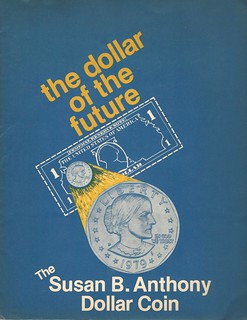 Books included, Groundbreakers, the History of the Northern Virginia Relic Hunters Association, published in 2023, Who's Who in the Jewish-American Hall of Fame, by Mel Wacks, Dollar of the Future – The Susan B. Anthony Coin, by unknown author, circa 1978, Gold and Silver Coins of the World including Crowns, Cut – Counterstamped and Siege Pieces – Rarities from the Collection of King Farouk, by Hans M.F. Schulman, 1955, Untangling the Record – A Contemporary review of Potosi and Lima Mint Coins and Assayer History from the Mint Openings up to 1622 and Treasure Coins of the Nuestra Senora do Atocha & the Santa Margarita, both by Carol Tedesco, Beautiful Banknotes of France by Peter Jones (inadvertently given away but soon recovered by the true owner), original manuscript papers including Historical Synopsis of Provisional Currencies by Walter Breen, and several free giveaway history books from Steve Bishop. Thanks Steve! And then a half dozen pizzas arrived with heaping grease and cheese, in proximity to all the numismatic treasures which quickly vanished back into owner's satchels not a moment too soon.
Books included, Groundbreakers, the History of the Northern Virginia Relic Hunters Association, published in 2023, Who's Who in the Jewish-American Hall of Fame, by Mel Wacks, Dollar of the Future – The Susan B. Anthony Coin, by unknown author, circa 1978, Gold and Silver Coins of the World including Crowns, Cut – Counterstamped and Siege Pieces – Rarities from the Collection of King Farouk, by Hans M.F. Schulman, 1955, Untangling the Record – A Contemporary review of Potosi and Lima Mint Coins and Assayer History from the Mint Openings up to 1622 and Treasure Coins of the Nuestra Senora do Atocha & the Santa Margarita, both by Carol Tedesco, Beautiful Banknotes of France by Peter Jones (inadvertently given away but soon recovered by the true owner), original manuscript papers including Historical Synopsis of Provisional Currencies by Walter Breen, and several free giveaway history books from Steve Bishop. Thanks Steve! And then a half dozen pizzas arrived with heaping grease and cheese, in proximity to all the numismatic treasures which quickly vanished back into owner's satchels not a moment too soon.
The last we saw of our guest, Lorne LaVertu, he was loading the trunk of his sedan with a heavy cardboard box of donated numismatic literature for the Fairfax Coin Club, and packing assorted numismatists into the front and back seats, all of whom were hoping for a free lift to the Metro. We hope Lorne wants to come back to future dinners despite all the happy chaos that these normal Nummis Nova nights can bring.
Thanks, Tom! Here are some more details from the owners of the displayed items. -Editor
1769 8 Real
Lorne provided these images of his AU 1769 8 Real coin from a Daniel Sedwick auction. Nice coin!
Counterstamps
Dave Schenkman brought these counterstamps on 1843 and 1876 half dollars.
Cut Down Large Cents
Dave also had two interesting cut-down U.S. Large Cents. The octagonal one has a counterstamp. What were these used for?
Obsolete Paper
Finally, Dave also brought a couple great obsolete banknotes.
"This note is rare, and one of a tiny number of notes issued by mines in New York. The company operated in the 1870s."
"I was glad to be able to purchase this one; the timing was great, because I'm putting the final touches on a catalog of coal company mining notes; I had this listed, but didn't have a picture. I included the following notes: The Wisconisco Coal Company was established in 1831, and the first coal was mined the following year. The company's connection with the Wiconisco (note spelling) Canal Company is not known, but there obviously was one. Although Wiconisco is the correct spelling of the name (it was taken from a creek by the same name), newspaper articles of the 1830s and 1840s vary in the spelling of both the canal and the coal company."
Lion Dollars - Real or Counterfeit?
Tom Kays had a case of Lion Dollars (leeuwendaalders) to quiz attendees with.
Tom writes:
"Answer: Lion dollars were trade coins issued from provinces and imperial cities of the Republic
of the United Netherlands during the Golden Age
of Dutch world-wide sea power. Seven
Protestant northern provinces of the Netherlands would fight Catholic Spanish/Portuguese
rulers for freedom and trade supremacy for eighty years before officially securing the peace in
1648. Lion dollars were struck from 1575 to 1713, intended for circulation in distant trading
posts throughout the Dutch overseas territories, from the Turkish Ottoman Empire to New
Amsterdam (later New York) in North America. In each case, the first coin (pictured left) is
genuine and the second coin (pictured right) is counterfeit. Counterfeits and imitations may
have better or worse detail than the crude originals."
Steve's Beauties
Steve brought a number of toned type coins and a great macerated currency postcard.
Steve writes:
"Although I don't have a picture of the message side, the postcard has interesting content. The writer mentions passing Harper's Ferry where John Brown led his uprising, and leaving the Potomac on the way to see the Blue Ridge."
Thanks, everyone. It was another great evening of numismatic fellowship. Guest Lorne stepped up in two ways, accepting my box of giveaways on behalf of the Fairfax Coin Club, and giving Jonas and Kellen a ride to the Metro station for their journeys home. Thank you! See the following article in this issue for my further numismatic adventures this week.
WAYNE'S NUMISMATIC DIARY: FEBRUARY 26, 2023, PART 2
James Haas and Hermon Atkins MacNeil
The following day (Ash Wednesday, February 22, 2023) I had another fun numismatic encounter, for the first time meeting James Haas, author of Hermon Atkins MacNeil: American Sculptor in the Broad, Bright Daylight , creator of the Standing Liberty Quarter and multiple medals.
Jim lives in Maryland, and I was able to arrange for him to speak at a lunch with some collecting friends in Odenton.
We met at a local place called The Hideaway. Suggested by Jim and seconded by me (I love the pulled chicken BBQ sandwich), it's definitely hidden away. Jim had literally gotten lost looking for it back in the 1970s. Today's it's larger and a little easier to find, but only if you've been there before or use GPS directions. You get off the main road, pass a Ruth's Chris steakhouse, an old church with a spooky cemetery, and a waterproofing factory before arriving at the parking lot. Definitely an old-time local place feel.
I didn't get a selfie, but here's a photo of Jim Haas and the cover of his great book.
It was a group of about ten. Those of us arriving early chatted in the parking lot a bit before heading in to our table. After ordering, Jim gave us a nice overview of MacNeil's life and work and connections to the town of College Point, NY. He'd kindly brought along a few handouts to illustrate his talk.
Along the way someone asked about MacNeil's personal example of the Standing Liberty Quarter and shared a link to this CoinWeek article.
To read the complete article, see:
MacNeil's Personal 1916 Standing Liberty Quarter at ANA Money Show
(https://coinweek.com/us-coins/macneils-personal-1916-standing-liberty-quarter-at-ana-money-show/)
Attendees passed around a number of numismatic items, including a few nice slabbed Standing Liberty Quarters. Jim writes:
"The best surprise was being able to hold in my hands real life, mint condition MacNeil Quarters. That was an unexpected treat. Hindsight being what it is, had I tossed all of these coins into a coffee can, who knows what I might have or have sold?"
Happy Birthday, Hermon Atkins MacNeil! Jim provided these images for The E-Sylum.
Jim writes:
"MacNeil was born in Everett, MA on February 27, 1866 and died in College Point on October 3, 1947."
To read the earlier E-Sylum articles, see:
NEW BOOK: HERMON ATKINS MACNEIL
(https://www.coinbooks.org/v25/esylum_v25n43a02.html)
HERMON MACNEIL PLASTERS ON THE MOVE
(https://www.coinbooks.org/v25/esylum_v25n46a09.html)
HERMON MACNEIL PLASTERS MOVE COMPLETED
(https://www.coinbooks.org/v25/esylum_v25n48a13.html)
Dwight Musser Publication
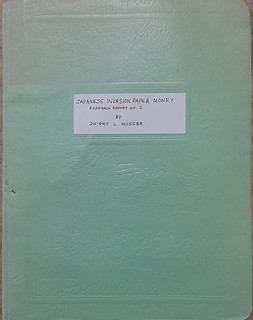 Rounding out my numismatic week, one evening I got around to digitizing a Dwight Musser publication for the Newman Numismatic Portal. In December Dennis Hengeveld inquired about some early publications on world paper money published by Dwight Musser. We're still looking for most of them (see the linked article below), but former Nummis Nova regular Howard Daniel (now retired to Florida) sent me his copy of Musser's Research Report No. 2 on Japanese Invasion Paper Money published in 1963. Thanks, Howard!
Rounding out my numismatic week, one evening I got around to digitizing a Dwight Musser publication for the Newman Numismatic Portal. In December Dennis Hengeveld inquired about some early publications on world paper money published by Dwight Musser. We're still looking for most of them (see the linked article below), but former Nummis Nova regular Howard Daniel (now retired to Florida) sent me his copy of Musser's Research Report No. 2 on Japanese Invasion Paper Money published in 1963. Thanks, Howard!
To read the publication on NNP, see:
Japanese Invasion Paper Money
(https://nnp.wustl.edu/library/book/623920)
To read the earlier E-Sylum articles, see:
DWIGHT L. MUSSER (1926-2018)
(https://www.coinbooks.org/v23/esylum_v23n13a05.html)
EARLY WORLD PAPER MONEY PUBLICATIONS SOUGHT
(https://www.coinbooks.org/v25/esylum_v25n49a14.html)
COUNTERFEIT CANADIAN 'CAMEL TOE' TOONIES
Allan Behul submitted this article on the counterfeit Canadian two-dollar coin, also known as the "camel toe toonie". Thank you. -Editor
Camel Toe Toonie
A.J. Behul
If you stopped an average Canadian on the street, and asked about counterfeiting in Canada,
(s)he would probably think of $50 or $100 dollar bills; the thought of the toonie
(or
Canadian two-dollar coin) probably not the first thing to come to mind, yet it is this
particular denomination, that has made its way into news headlines for the last two to three
years.
Specifically, the camel toe toonie
; the self-explanatory moniker, quickly made apparent,
after looking closely at the right forepaw of the polar bear image, located on the reverse
side of the bi-metallic coin.
According to Brent W.J. Mackie, Treasurer of the Waterloo Coin Society, and dedicated
researcher of the camel toe toonie
, the counterfeit coins were first reported in coin chats
and forums in July 2020, and specimens continue to be discovered in circulation across the
country up to present-day; the GTA (or Greater Toronto Area) identified, among others, as
one of the counterfeiting hotspots.
Counterfeit coins have been found dated: 1996, 2002, 2004, 2005, 2006, 2007, and 2010.
Identifiable characteristics of the camel toe toonie
consist of the split-toe
on the right
forepaw previously mentioned, extra lines on the left side of the ice floe, located behind the
bear's right hind paw, and font differences on a number of legends and dates.
Others include the omission of the initials SB
(representing the artist Susanna Blunt),
usually found on the neckline of the effigy of the Queen on the obverse side, on
counterfeits dated 2004, 2005, 2006, 2007, and 2010, and softer
, less defined initials
BT
(for the artist Brent Townsend), on the reverse side.
It is interesting to note, that the number of camel toe toonie
types and varieties that have
been identified is so extensive, that Mackie decided to create a user-friendly numbering
system, to assist with cataloging, which can be found on his webpage
cameltoetoonies.ca.
At this point, we may find ourselves asking, O.K. but how big of a problem could it really
be...I mean it's only a toonie, right?
Actually, significant.
Mackie (conservatively) estimates that there could be five million counterfeit toonies in circulation, but the actual number is probably much higher; taking into consideration an overall saturation rate of 0.5% against a cumulative mintage of genuine toonies issued by the RCM (Royal Canadian Mint).
The genuine coin on the left versus the counterfeit on the right. Genuine: Fine details of the bear's paws. 2a: The polar bear's paw is misshapen.
In a press release dated May 9, 2022, the RCMP (Royal Canadian Mounted Police) stated
that approximately 10,000 counterfeit toonies were identified and seized, following an
investigation conducted by the GTA-TSOC (Greater Toronto Area Trans-National Serious
& Organized Crime) Section, which resulted in charges being laid against a Richmond Hill,
Ontario resident, including Uttering counterfeit money
and Possession of counterfeit
money
, contrary to Section 452 and 450 respectively, of the Canadian Criminal Code.
The RCMP also commented that it is suspected that there are additional counterfeit coins
in the currency system and that the coins originate from China
.
Perhaps a subsequent question that we may have would be, Is it really worth it to the
counterfeiters?
(Aside from the inherent risk of being involved in unlawful activity and
facing criminal prosecution of course).
Apparently so.
If the cited volume of counterfeit camel toe toonies
in circulation is any indication, then it
may be a question of economy of scale
, through which production costs on a per-unit
basis decrease, as the output (or volume) increases. In other words, the more you make, the
cheaper it becomes to make that product (in this case, each counterfeit toonie).
It is quite likely that we will have to wait for some time, to see where this story ends, who
the criminal author(s) were, and what methods were used to introduce the camel toe
toonie
into circulation, so as to prevent future recurrences.
In the meantime, the next time you are waiting in line for a coffee or beverage (living in, or
visiting Canada), have a look at the two-dollar coin that may be lying innocuously in
between your pocket change; you may just find the now infamous camel toe toonie
.
P.S. If you do chance upon a counterfeit toonie, or believe someone has attempted to pass along counterfeit currency to you, as indicated by the RCMP, it should be reported to the local police, the Ontario RCMP, or anonymously through Crime Stoppers.
To read the RCMP press release, see:
RCMP investigation leads to counterfeit currency charges
(https://www.rcmp-grc.gc.ca/en/news/2022/rcmp-investigation-leads-counterfeit-currency-charges)
1849 OREGON FIVE DOLLAR GOLD BEAVER COIN
The Lewiston Tribune published an article about a local coin dealer who purchased an 1849 Oregon Five Dollar Gold Beaver pioneer gold coin. -Editor
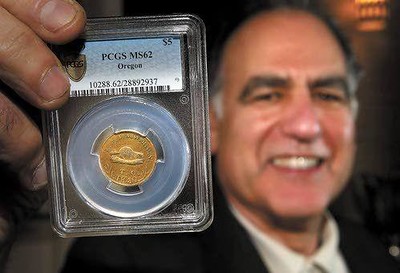 Owning rare, expensive coins is nothing new for David Nelkin, who regularly buys and sells them for a living.
Owning rare, expensive coins is nothing new for David Nelkin, who regularly buys and sells them for a living.
But Nelkin, the owner of Eugene Coin and Jewelry, is particularly proud these days about his purchase last year of a high-priced, rare coin from Oregon's era before statehood.
Now, he's about to show the 165-year-old "Beaver Coin" for the first time since he bought it.
"I'm just really ecstatic to own it," Nelkin said. "It's like owning a fabled piece of art. I look at it that way. And because I'm from Oregon, it has that extra pull."
Nelkin bought the $5 gold coin in August from a private collector, who had paid $257,000 for it at an auction three months earlier.
The coin was made in 1849, a decade before the Oregon Territory became a state.
It's unknown how many of the Oregon gold coins remain in existence. But fewer than 50 out of the 6,000 $5 coins made in Oregon City in the 19th century have been certified as authentic, Nelkin said.
"It's not about the money for me," Nelkin said. "It's about the coin. The art of the coin. The preservation of the coin, and its connection to the history of Oregon."
Nelkin, who keeps the coin in a bank safe deposit box, hasn't displayed the collectible since he bought it.
However, this week Nelkin will display it at the American Numismatic Association's "National Money Show" in Portland. The three-day event started Thursday.
To read the complete article, see:
Dealer just had to have 1849 'Beaver Coin'
(https://www.lmtribune.com/northwest/dealer-just-had-to-have-1849-beaver-coin/article_763a78e3-0778-5506-ac68-12e0a0d25887.html)
STOLEN OLYMPIC GOLD MEDALS REPLACED
Here's a great story from Vancouver, Canada about the replacement of two stolen Olympic gold medals. -Editor
Tracey and Brian Mead place the replica gold medals into a case, where they'll be on display at the BC Sports Hall of Fame in Vancouver, B.C. on Friday, Feb. 24, 2023.
More than 40 years after they were stolen, a pair of historic Olympic gold medals are back where they belong.
Sprinter Percy Williams stunned onlookers and inspired Canadians when he won both the 100 and 200-metre races at the 1928 Olympics in Amsterdam, but his story was marked by a "dark cloud" after a thief snatched the awards from the B.C. Sports Hall of Fame in 1980, said his cousin, Brian Mead.
That changed Friday when the Canadian Olympic Committee presented Williams' extended family with newly minted medals. The family then donated them back to the Hall.
"When people come now, they won't see (evidence of the theft) or even hear it. They'll look at his display, see his accomplishments, see his medals. And then they'll go home thinking he was a great Canadian," Mead said.
Williams was a surprising athlete.
Born in 1908, he suffered rheumatic fever as a boy and told by doctors to take it easy. He didn't listen and instead drew attention for his natural speed despite his small stature, said B.C. Sports Hall of Fame curator Jason Beck.
"Physically, Percy Williams looked a lot different than what we expect a big, powerful, muscular sprinter to be today," Beck said. "He was only five foot six in height and weighed a wispy 125 pounds."
Expectations for the Vancouver native were low when he lined up to race in Amsterdam. After powering through the 100m heats and the semifinals, though, Williams streaked down the track in 10.8 seconds to take gold in the finals.
"(The win) was so unexpected that organizers had to scramble to find a Canadian flag for the medal ceremony," Beck said.
Williams was inducted into the Canadian Olympic Hall of Fame in 1949 and Canada's Sports Hall of Fame in 1955 before being made an Officer of Canada in 1979.
Before his death, Williams donated a trove of his memorabilia to the B.C. Sports Hall of Fame, including his medals. In 1980, just weeks after they were put on display, 16 of the medals were stolen, including the two Olympic golds. While some of the medals were returned anonymously about 15 years later, the golds were never recovered.
After learning about Williams and his legacy a few years ago, Brian and Tracy Mead asked the Canadian Olympic Committee to replace the medals.
The COC worked with the International Olympic Committee, which found the original moulds and specifications so the prizes could be remade.
The process was finally completed Friday when Smith handed Brian and Tracy Mead each a small brown box containing a medal exactly like the ones Williams received back in 1928. Each circular piece of gold has a raised image of a goddess sitting on a cloud and the words "Olympian Amsterdam 1928."
To read the complete article, see:
Olympic gold medals won by Percy Williams replaced 43 years after theft
(https://www.ctvnews.ca/sports/olympic-gold-medals-won-by-percy-williams-replaced-43-years-after-theft-1.6288314)
UKRAINE BANKNOTE MARKS ONE YEAR OF WAR
Ukraine has issued a commemorative banknote marking the one year anniversary of the Russian invasion. -Editor
Ukraine's central bank unveiled a commemorative banknote on Thursday to mark one year since the start of Russia's full-scale invasion, with one side depicting three soldiers raising the national flag.
The other side of the 20-hryvnia ($0.54) note features an image of two hands tied with tape, an apparent allusion to alleged war crimes Kyiv has accused Russian forces of committing in Ukraine.
"To mark the anniversary of the war, we decided to launch a commemorative banknote which will depict on a small piece of paper a year of emotions, patterns, content and iconic things," Andriy Pyshnyi, governor of the National Bank of Ukraine, said during a presentation at the central bank in Kyiv.
The central bank has worked hard since the invasion on February 24 last year to keep the economy afloat and maintain stability.
Pyshnyi said the new note, which contains innovative security features, will have a circulation of 300,000.
Central bank officials said it took about eight months to design and produce the note, and the bank plans a series of commemorative notes to provide a visual record of the war.
"During this year, Ukrainians have realized their force, their significance, their ability not only to withstand but also to win, to win without forgiving a single military crime, a single ruined house," Pyshnyi said. "This victory will be at a very high price but it will happen and it will be ours."
To read the complete article, see:
Ukraine unveils banknote to mark one year since Russia's full-scale invasion
(https://www.cnn.com/style/article/ukraine-banknote-russian-invasion-intl-scli/index.html)
LOOSE CHANGE: FEBRUARY 26, 2023
Here are some additional items in the media this week that may be of interest. -Editor
The Greysheet published a podcast with Dennis Hengeveld of World Banknote Auctions. -Editor
Patrick Perez sits down with the president and founder of the well-established auction house of paper money as the firm expands in to U.S. currency auctions as well.
The collectible currency field is growing rapidly and Dennis Hengeveld's auction house has been on of the hobby's best resources for fresh material for buying and selling world bank notes. Now the firm is expanding into the U.S. market with an auction. Patrick sits down with Dennis to dive in about his background, interests, and goals for his growing company.
To watch the video or listen to the podcast, see:
Exclusive Podcast with World Banknote Auctions' Dennis Hengeveld [Video]
(https://www.greysheet.com/news/story/exclusive-podcast-with-world-banknote-auctions-dennis-hengeveld-video)
Here's another YouTube video with Dennis Hengeveld. -Editor
Dennis Hengeveld and Ryan Baum discuss the Navy Commander Collection of US National and Gold Banknotes, selling March 10, 2023 at www.worldbanknoteauctions.com.
To watch the video, see:
Collector's Review: Things you didn't know about these National Banknotes
(https://www.youtube.com/watch?v=3JK3PsRN82k)
Silver Oceans "is a channel about stacking physical silver bullion, precious metals news, and macro perspectives on upcoming events." The host interviews Ron Guth about his history with the hobby, silver coinage, and the silver market over the years. 19,822 views! Check it out. -Editor
THIS is what numismatic expert Ron Guth says people are stacking in preparation for economic collapse. Ron Guth has been professionally involved in the silver and numismatic market for over 50 years as a stacker, collector, dealer, researcher, and author. He's also the creator of CoinFacts and he's held many top executive positions at Collectors Universe (PCGS). Coin World named him as one of the Top Ten Most Influential People in Numismatics from 1960-2020. In this video Ron explains that people are stacking a certain type of silver for economic collapse, a time when it becomes difficult to transact business with fiat government issued money. You won't want to miss this one!
Ron adds:
"Also, I conduct "Pick My Brain" livestreams on my YouTube channel every Wednesday night at 6:00 pm PST, where anyone can come on and ask questions about any aspect of numismatics. Here's a link to the livestream from February 8th: https://youtube.com/live/_49f4rpeIyA?feature=share"
To watch the video, see:
World-Renowned Silver Expert Ron Guth on What To Stack!! Economic Collapse & Silver Market History
(https://www.youtube.com/watch?v=Vh_V2psiDvo)
If collecting coins isn't fast-paced enough for you, how about Hot Wheels cars? -Editor
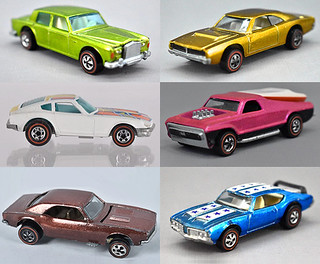 By day, Bruce Pascal is a successful commercial real estate executive who brokers multimillion-dollar deals in the nation's capital.
By day, Bruce Pascal is a successful commercial real estate executive who brokers multimillion-dollar deals in the nation's capital.
By night, he buys $5k Hot Wheels cars on eBay.
The 59 year old owns what is considered the world's most valuable Hot Wheels collection, a staggering array of 7k rare toy cars that are collectively insured for $1.5m. Many are prototypes that were acquired from former Mattel employees, including a pink 1969 Rear-Loading Beach Bomb valued at ~$150k.
Five decades ago, Hot Wheels were America's hottest new plaything. Today, the children of the ‘60s are fueling a small but mighty collectors' market that wheels and deals in obscure corners of the internet.
To read the complete article, see:
The collectors who spend thousands on rare Hot Wheels
(https://link.thehustle.co/view/5f3bcd6c2c81bf6314597294i8j0k.95y4/5776666d)
FEATURED WEBSITE: COUNTERFEIT TOONIES
This week's Featured Web Site is the counterfeit toonies catalogue discussed by .Allan Behul in another article in this issue.
"Since their introduction to Canadian circulation in 1996, our $2 coins, or "toonies" as we affectionately know them have been subject to two major series of counterfeit coins with a third series that got a lot of media attention."


